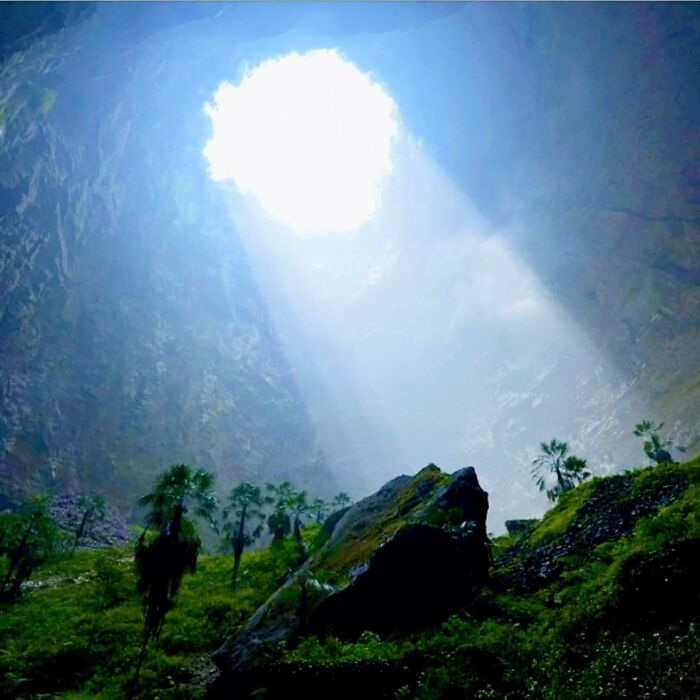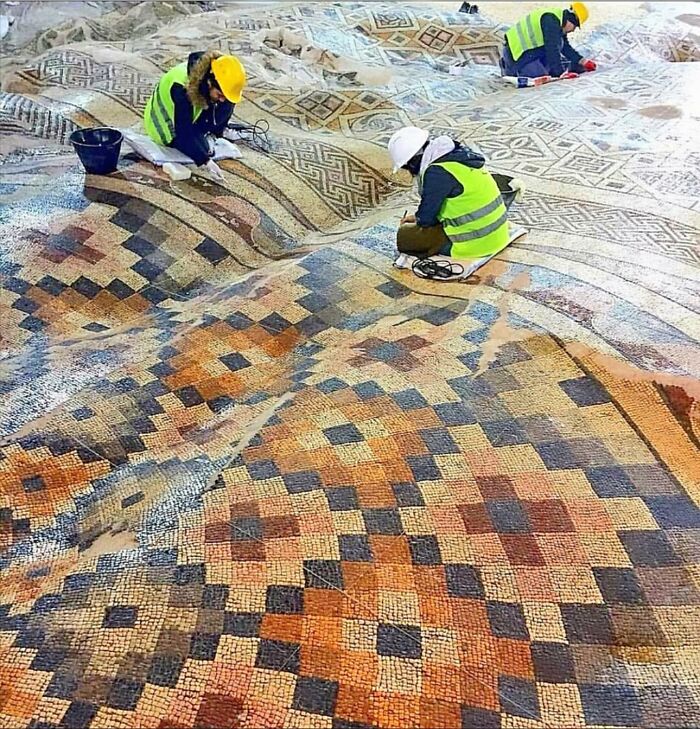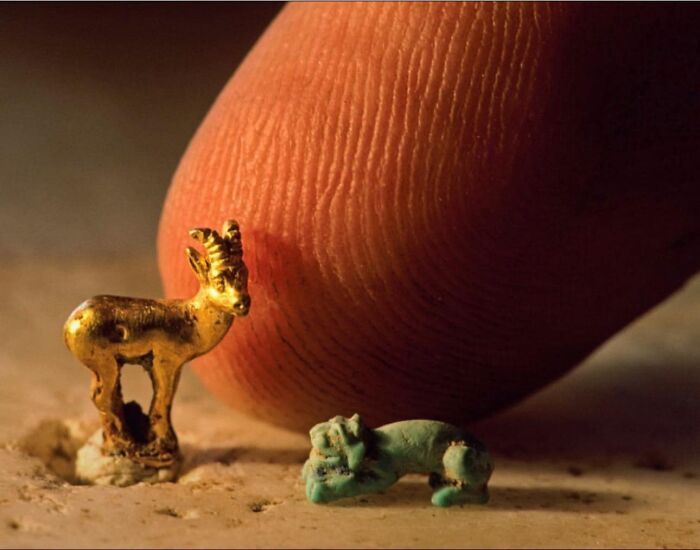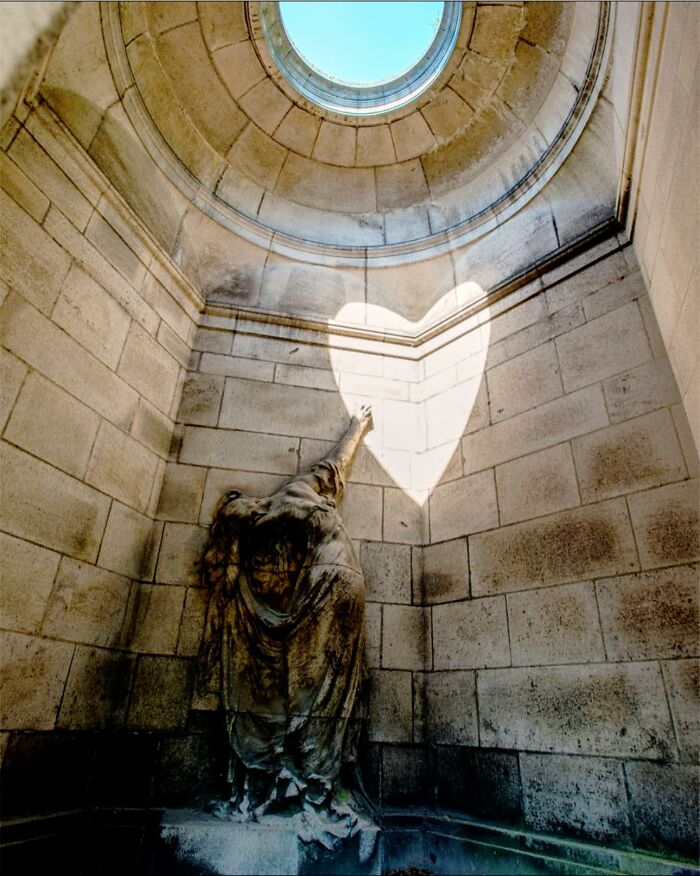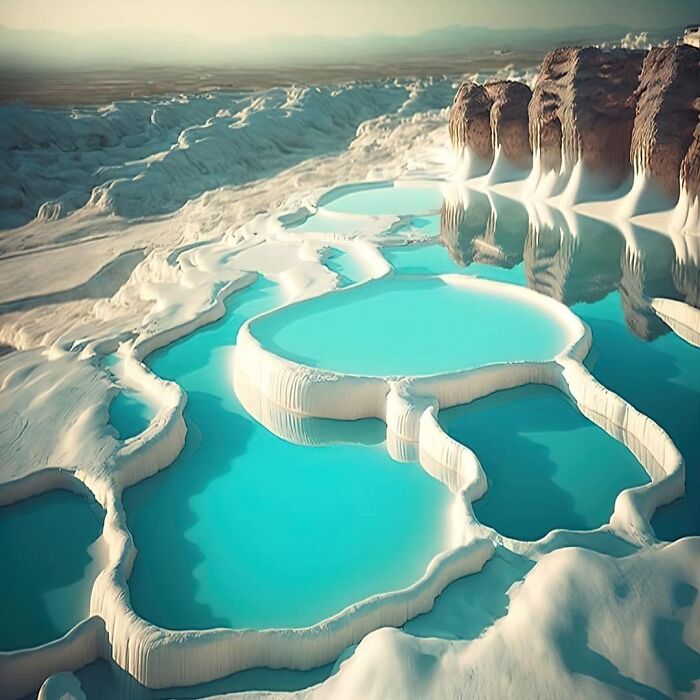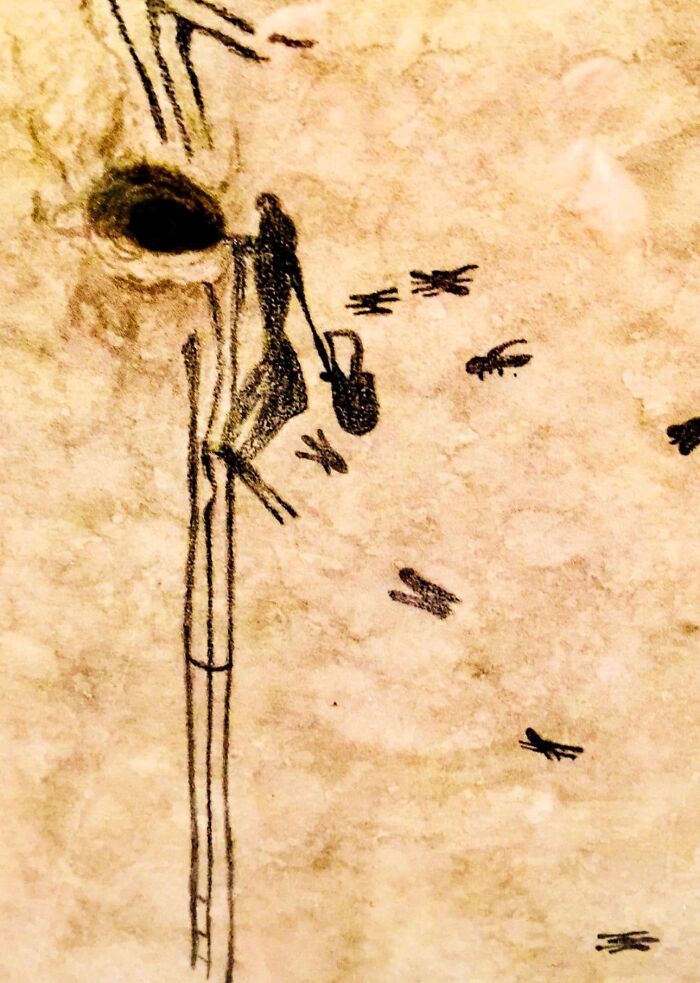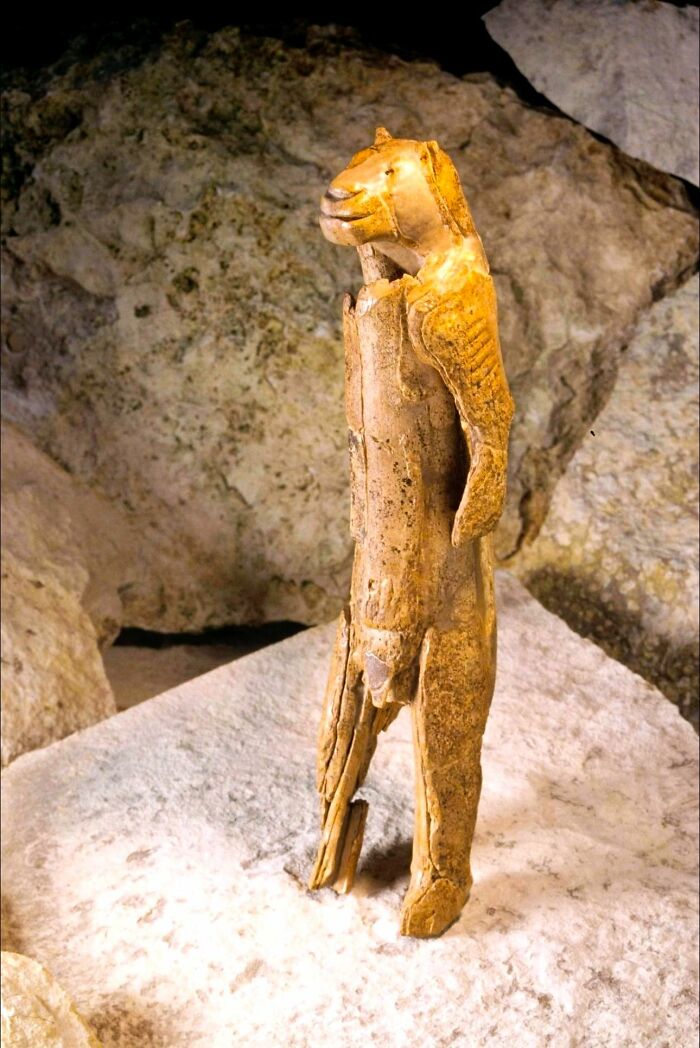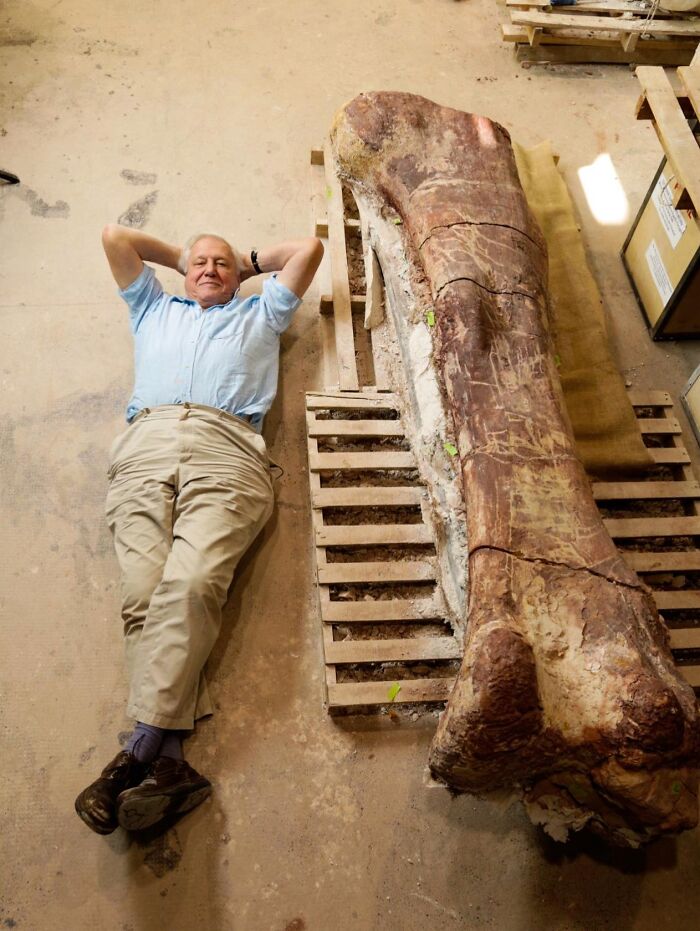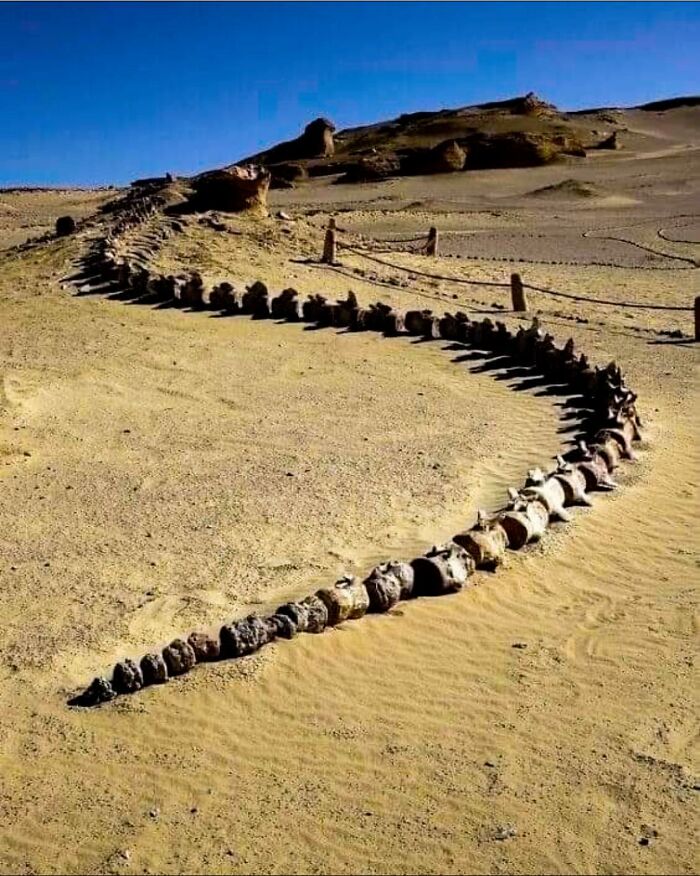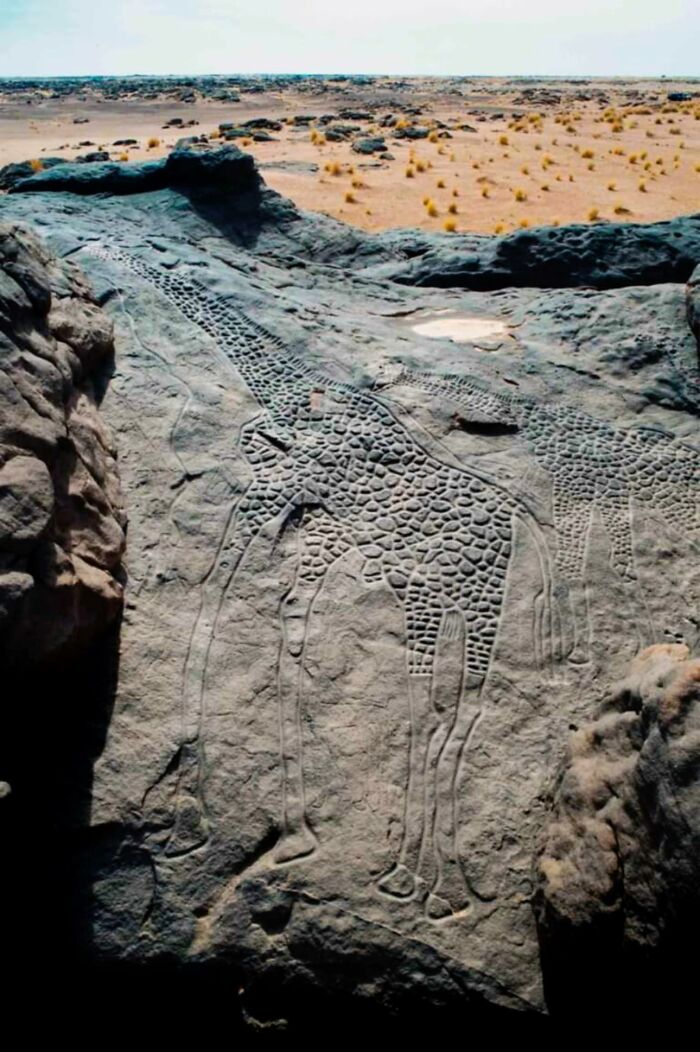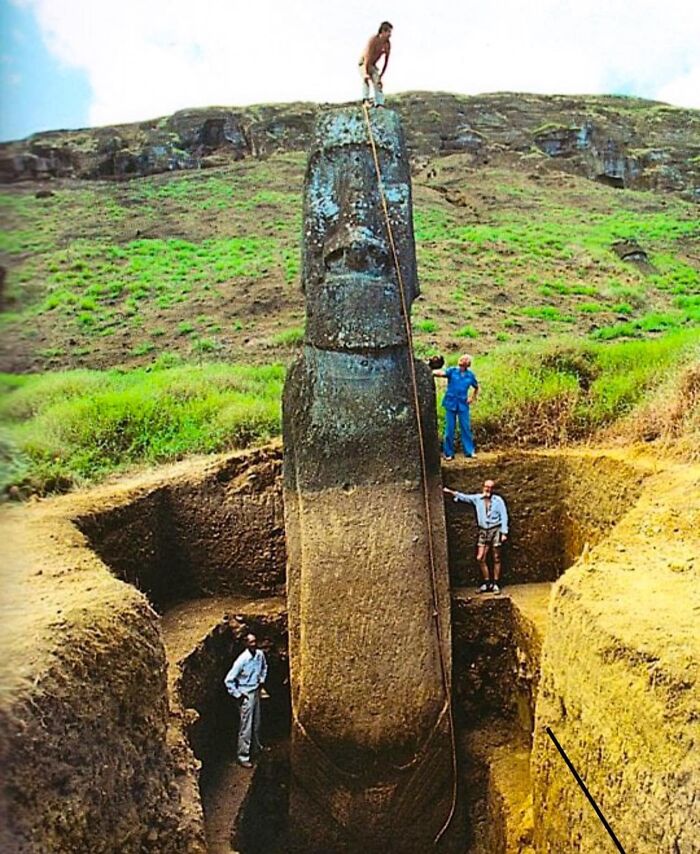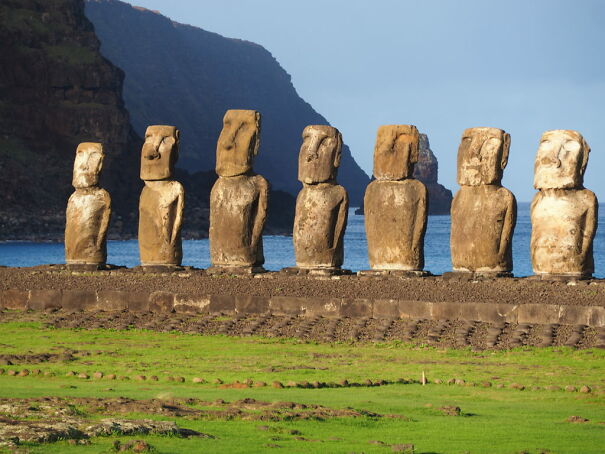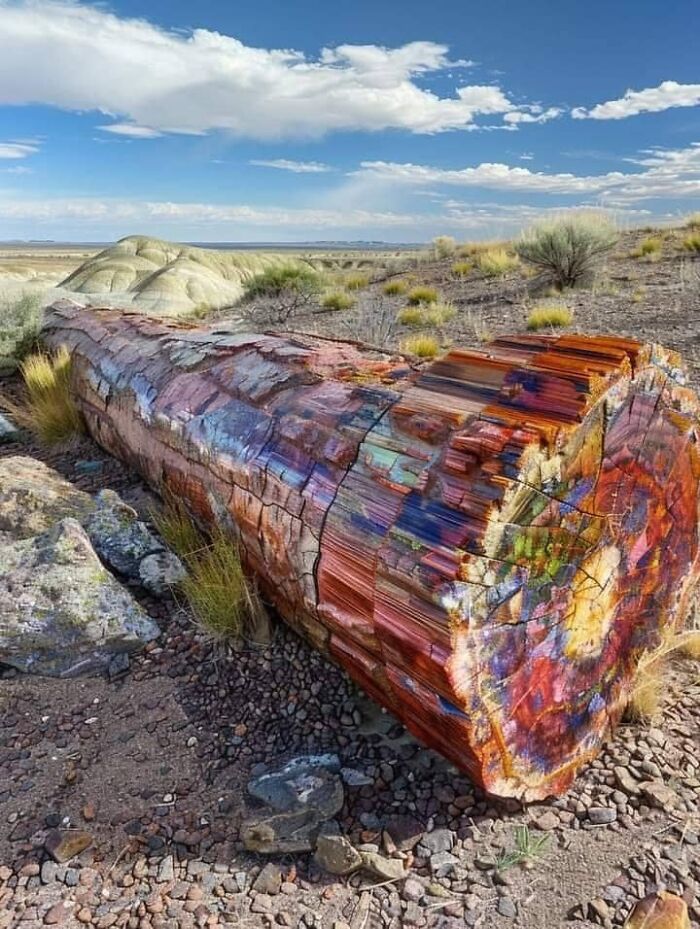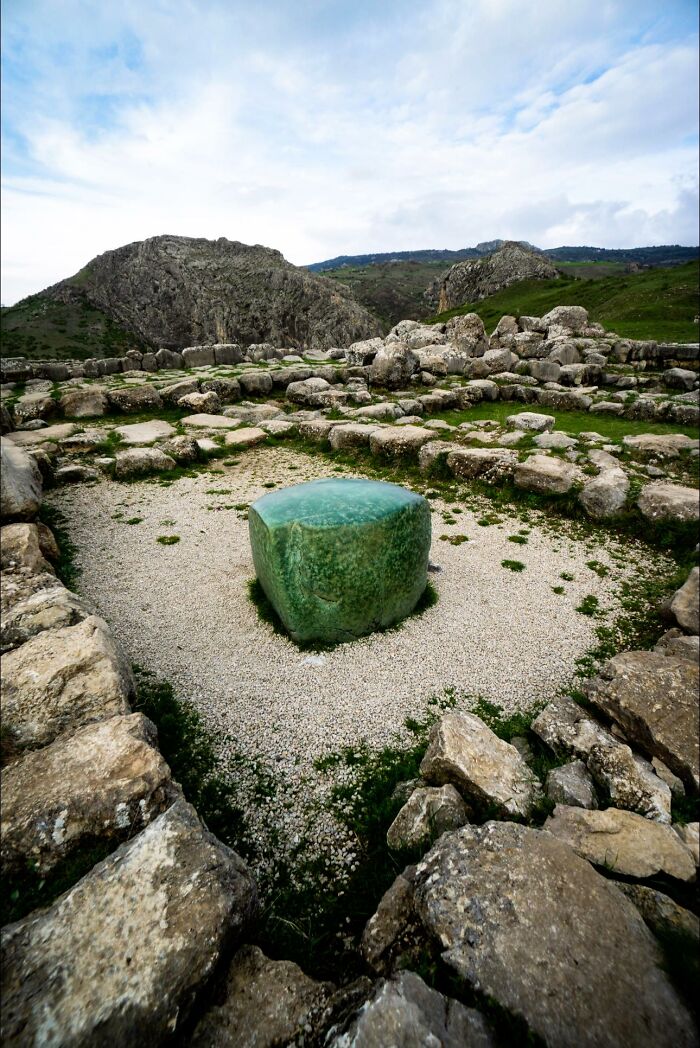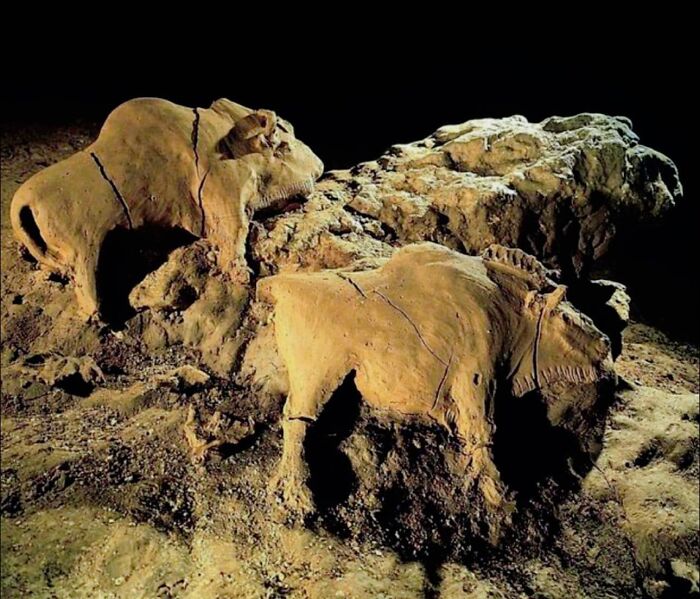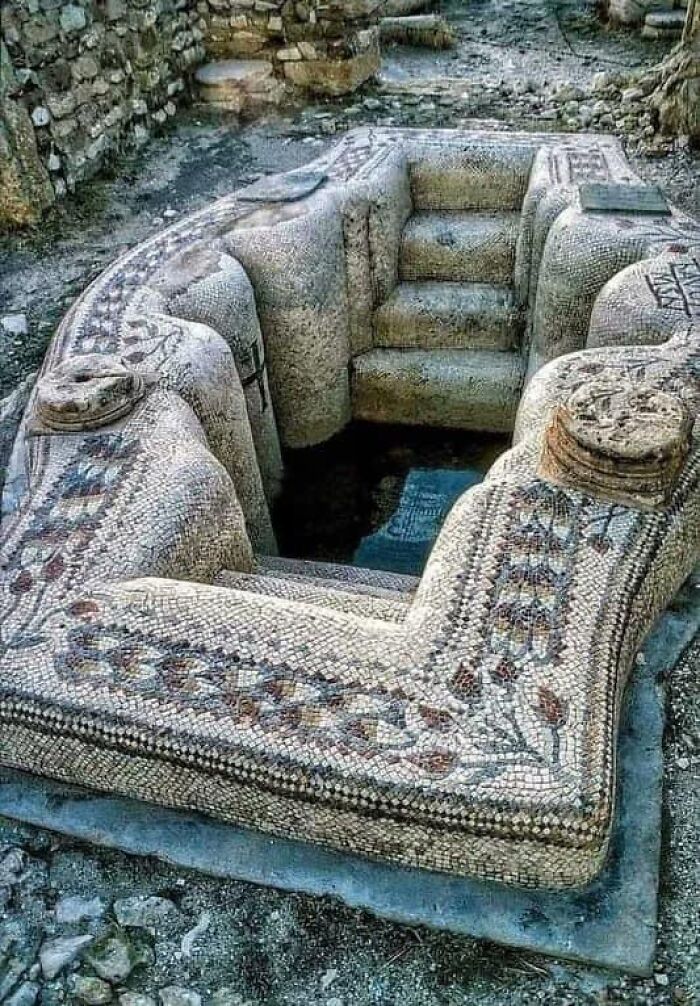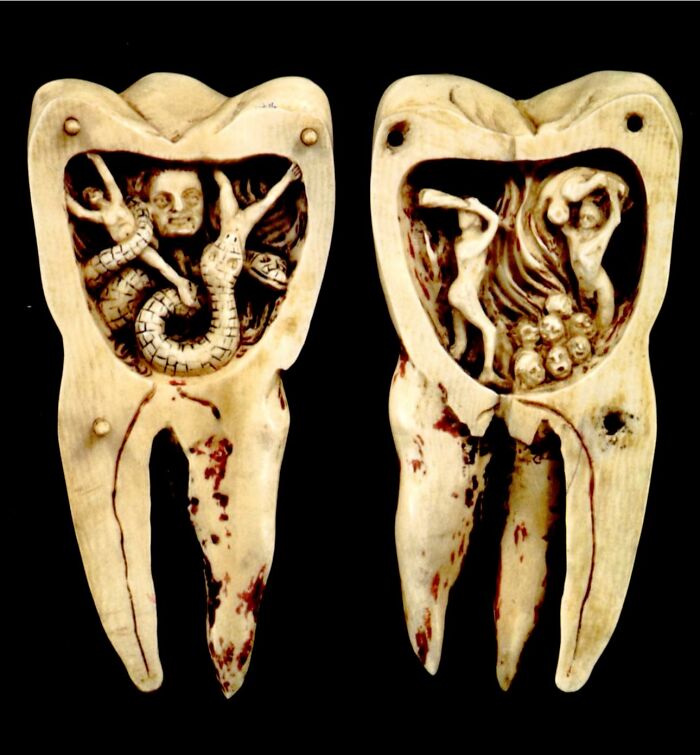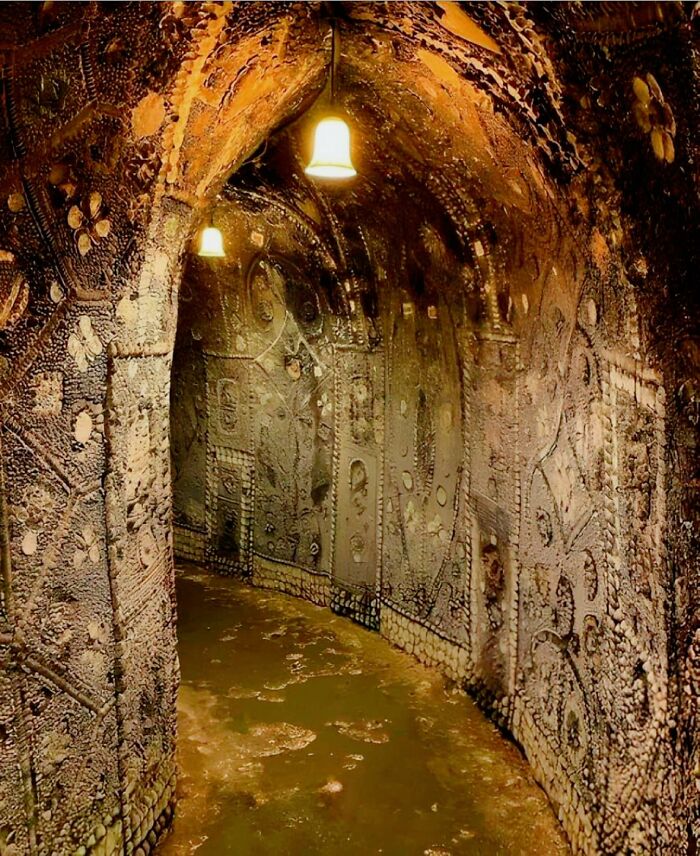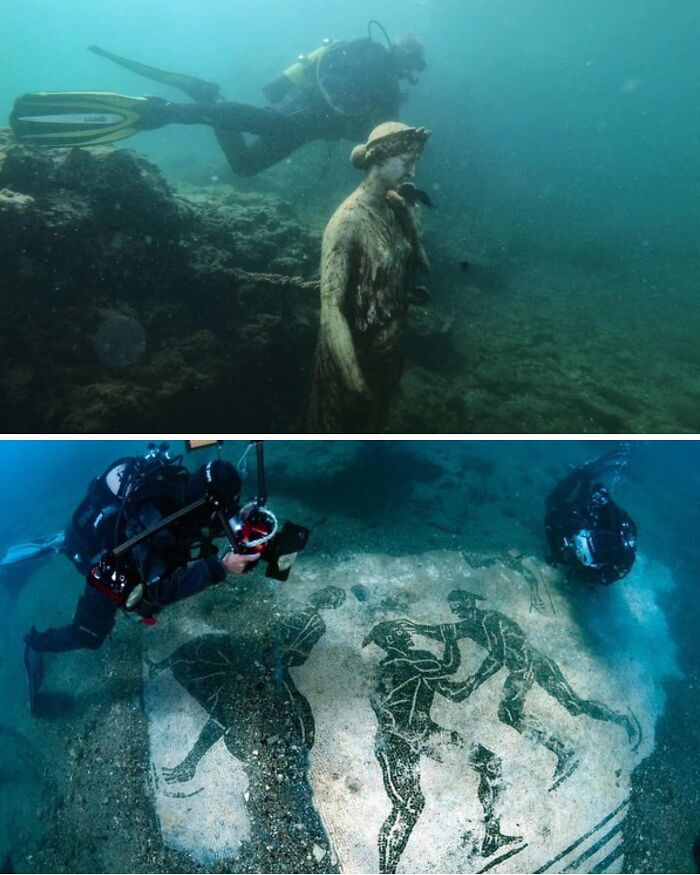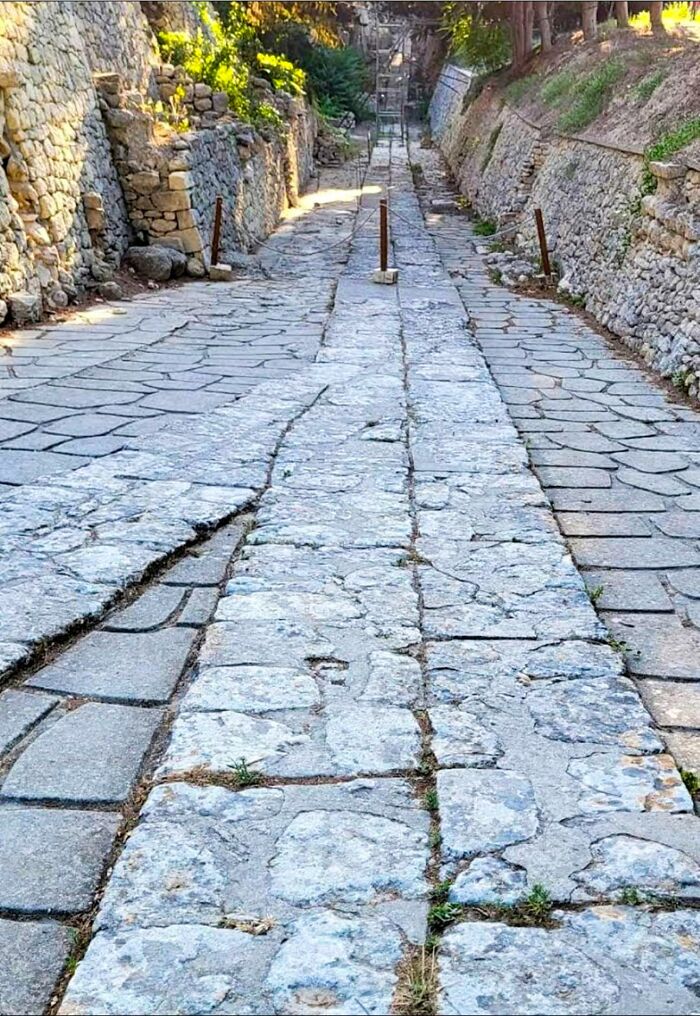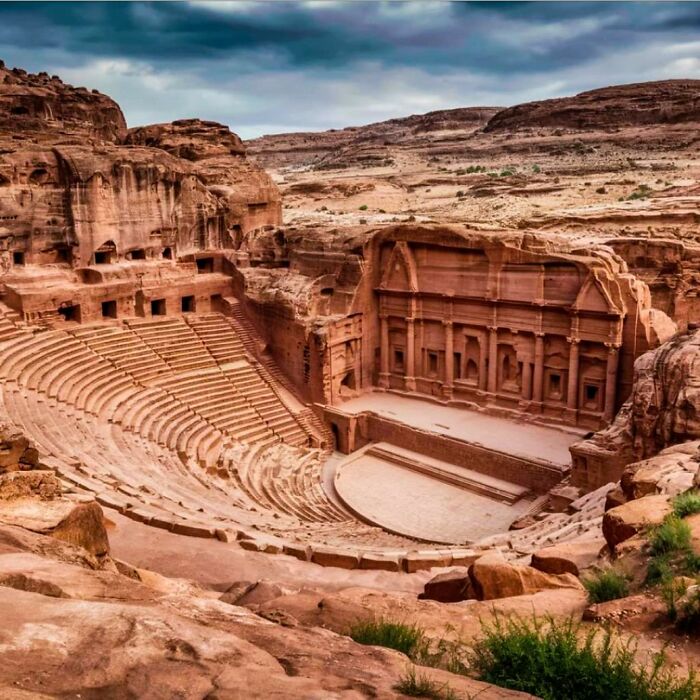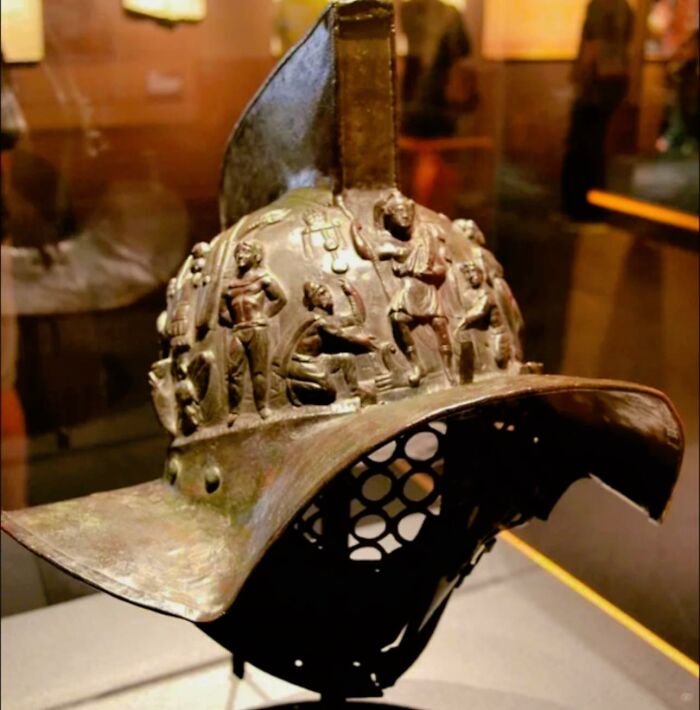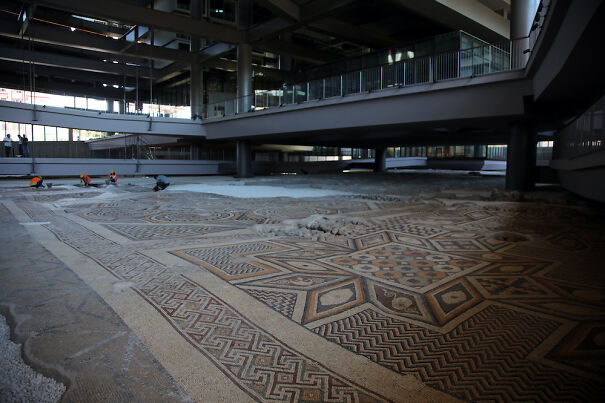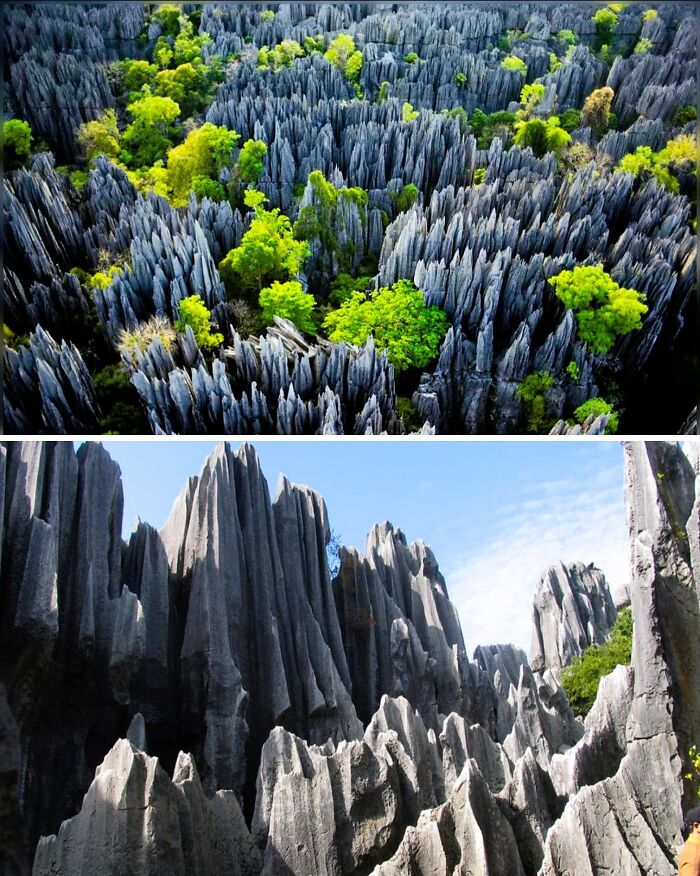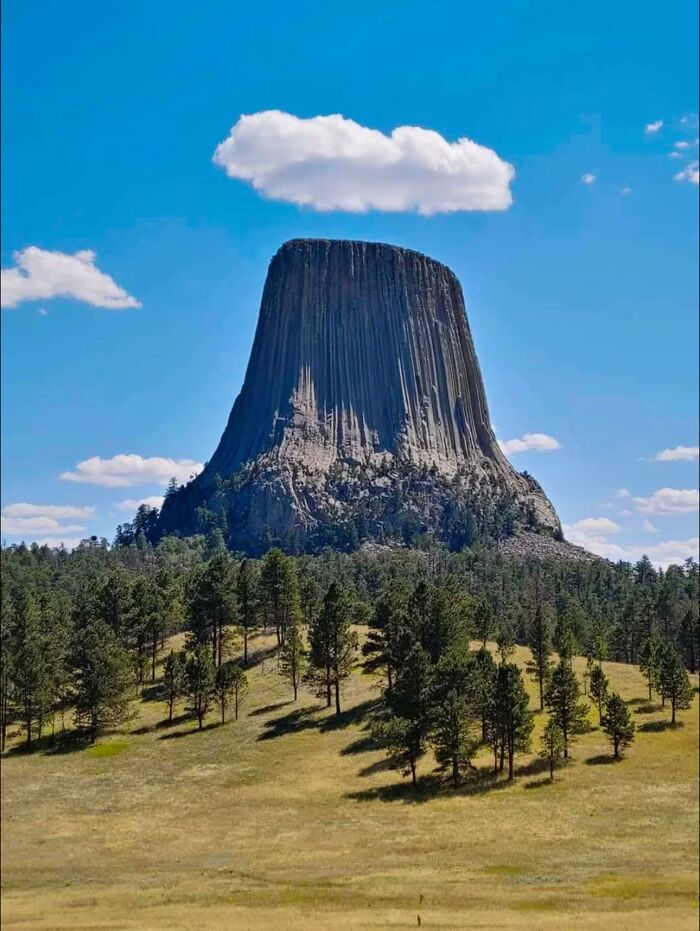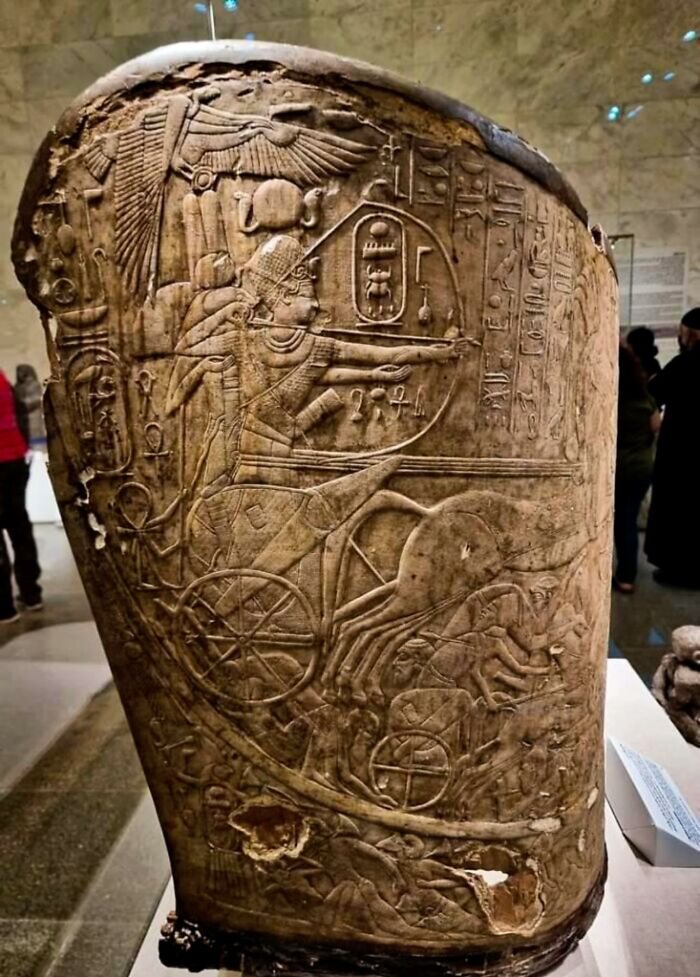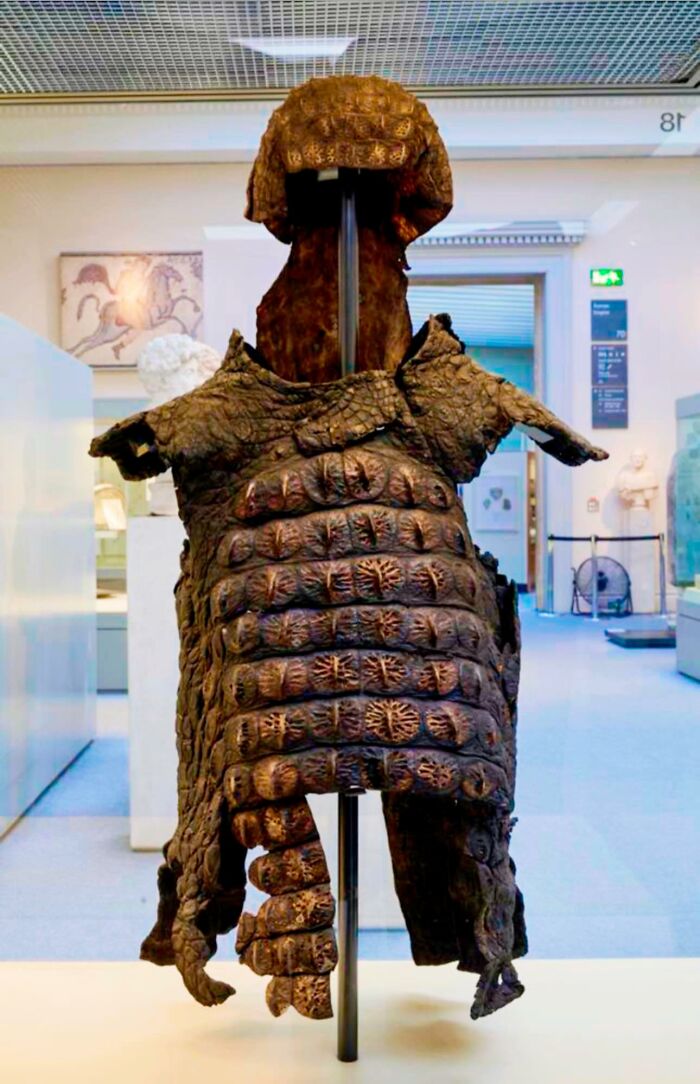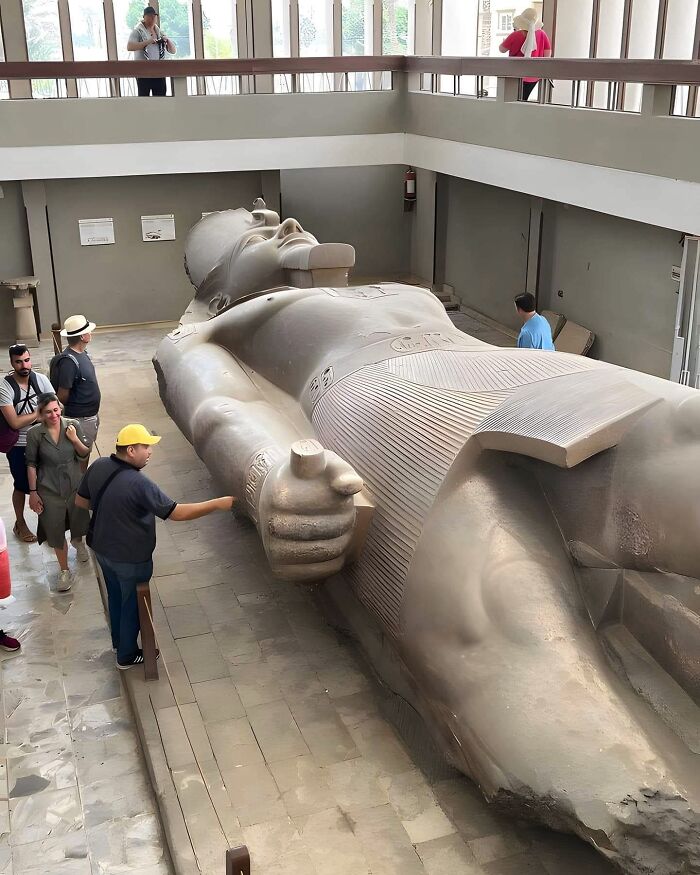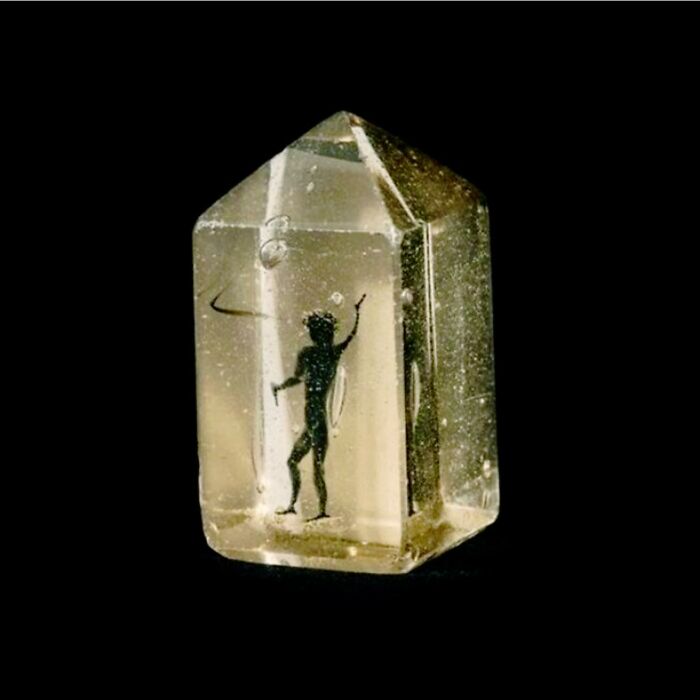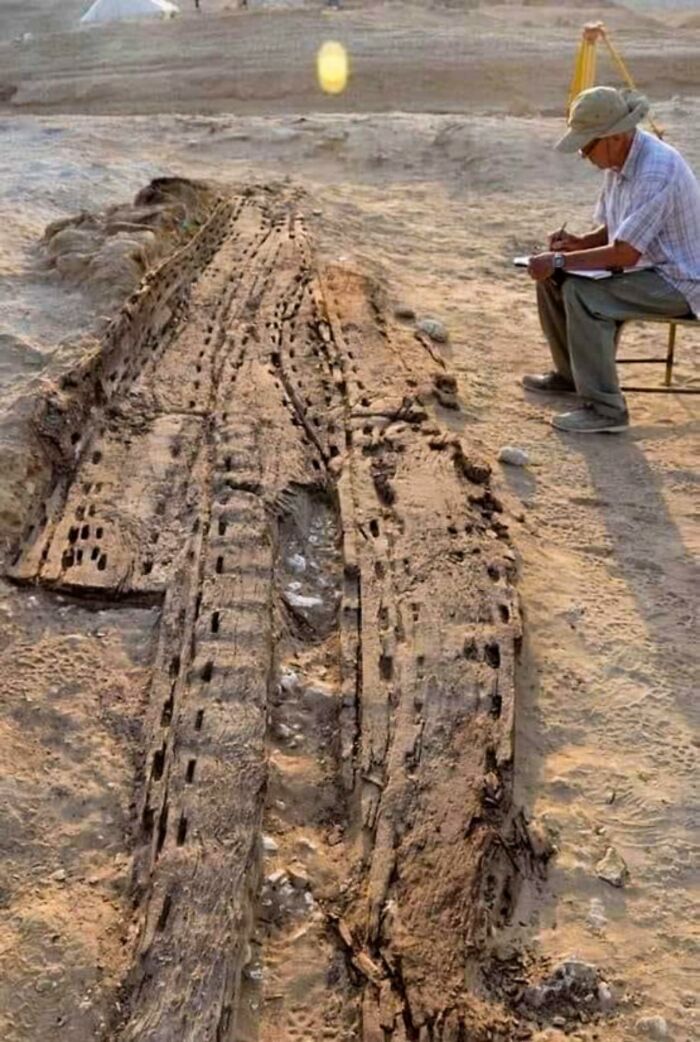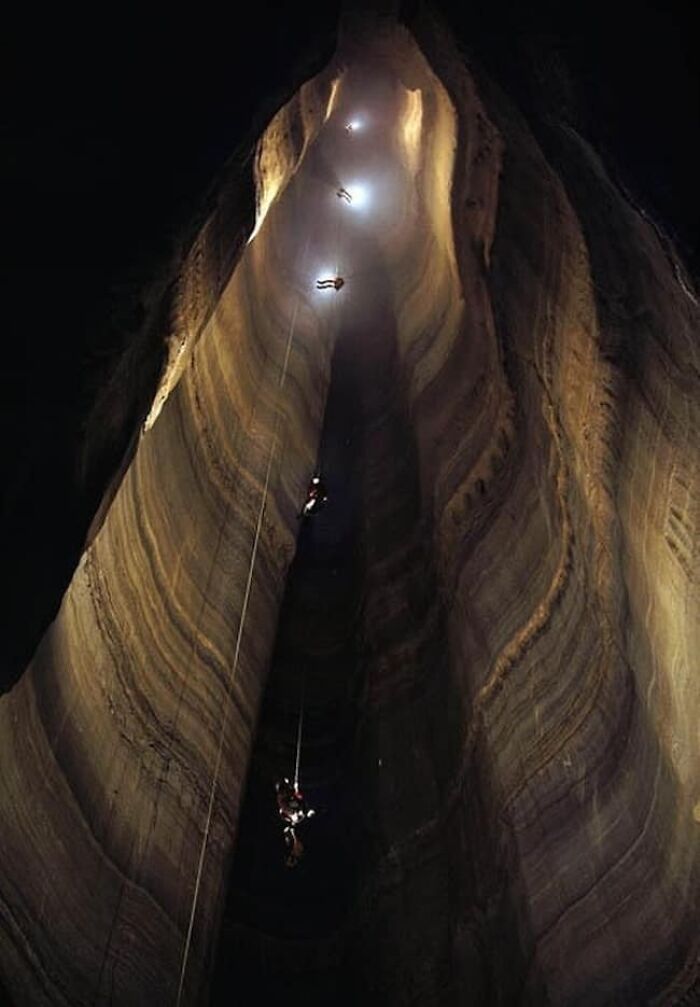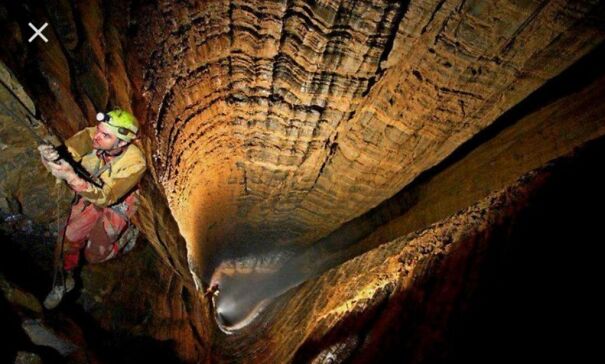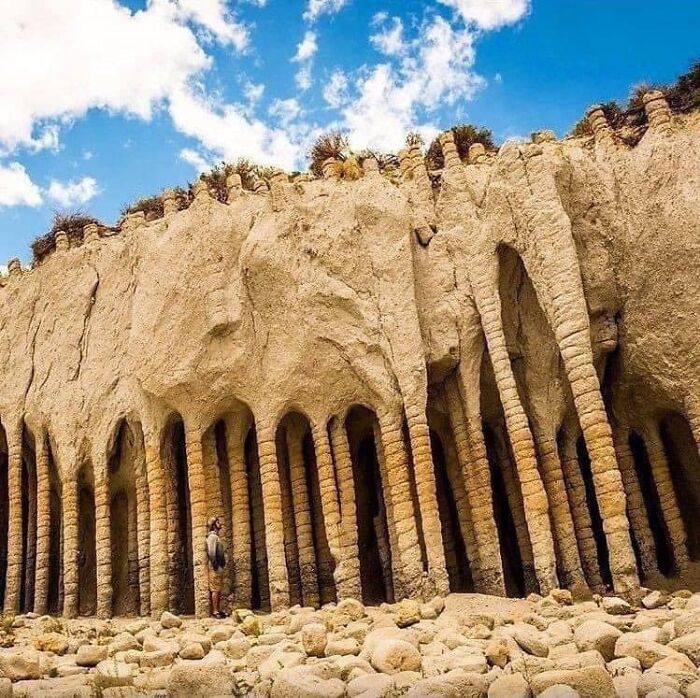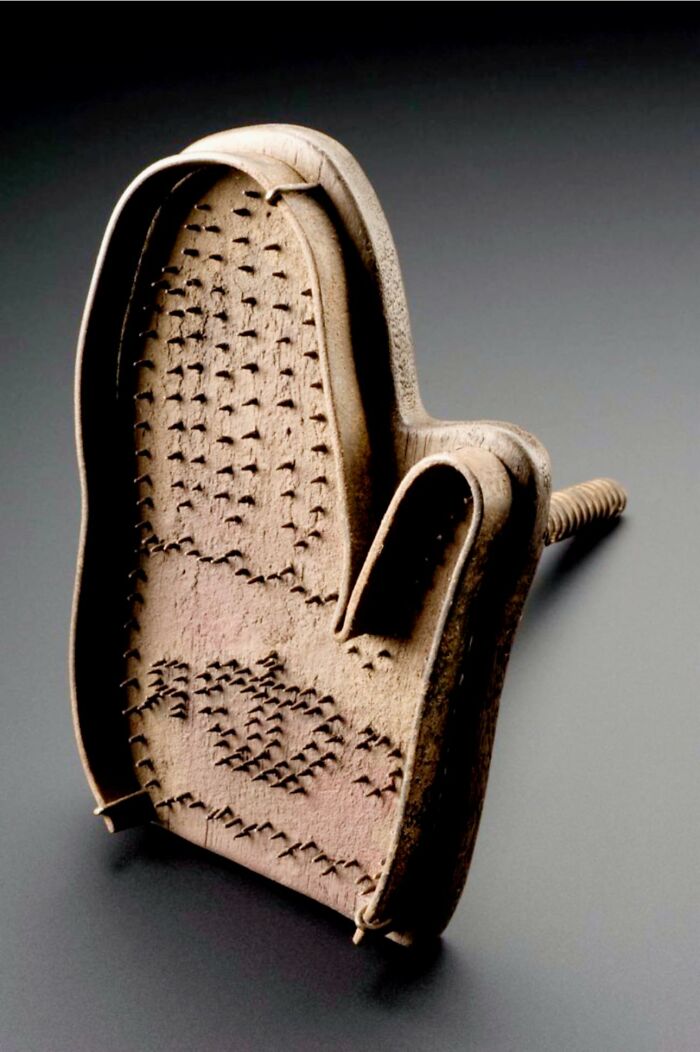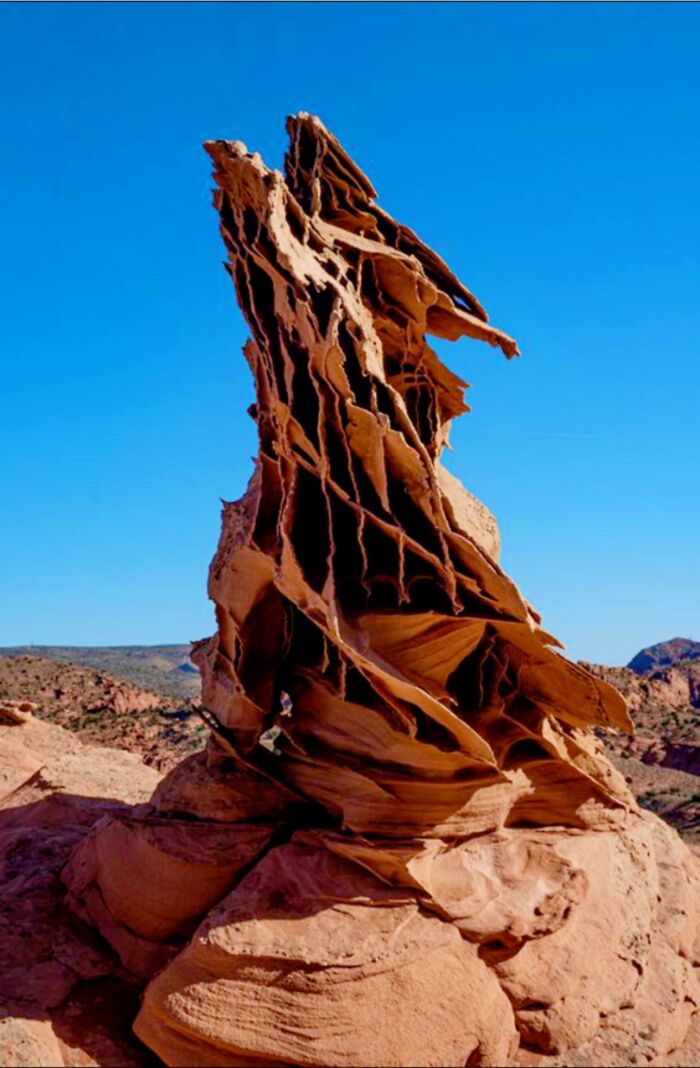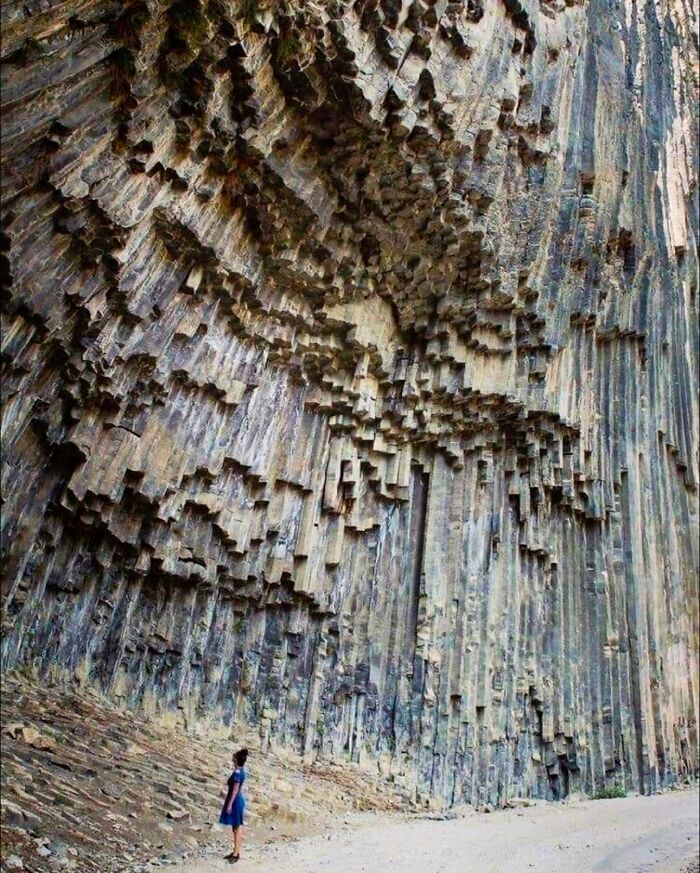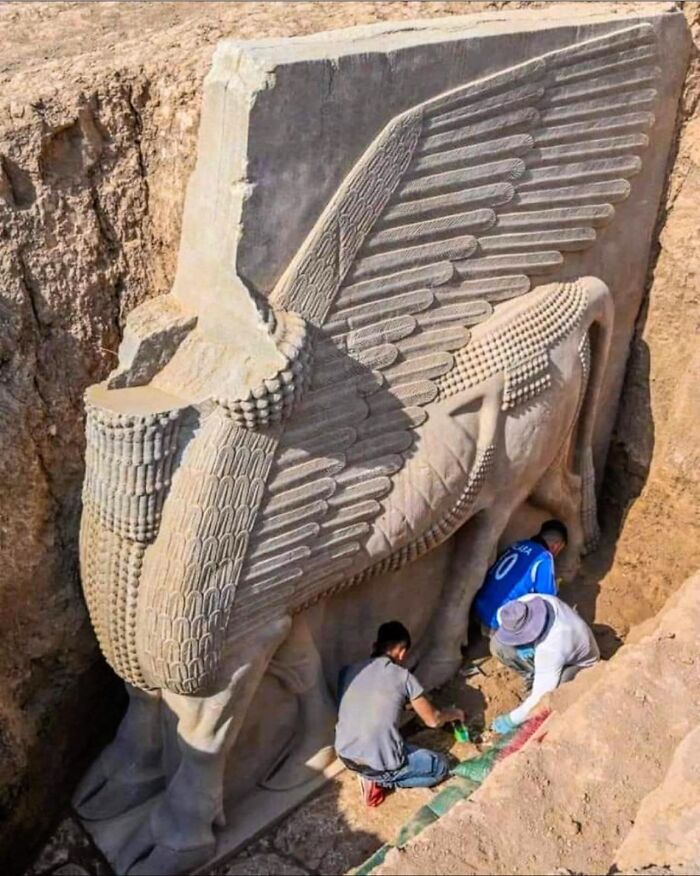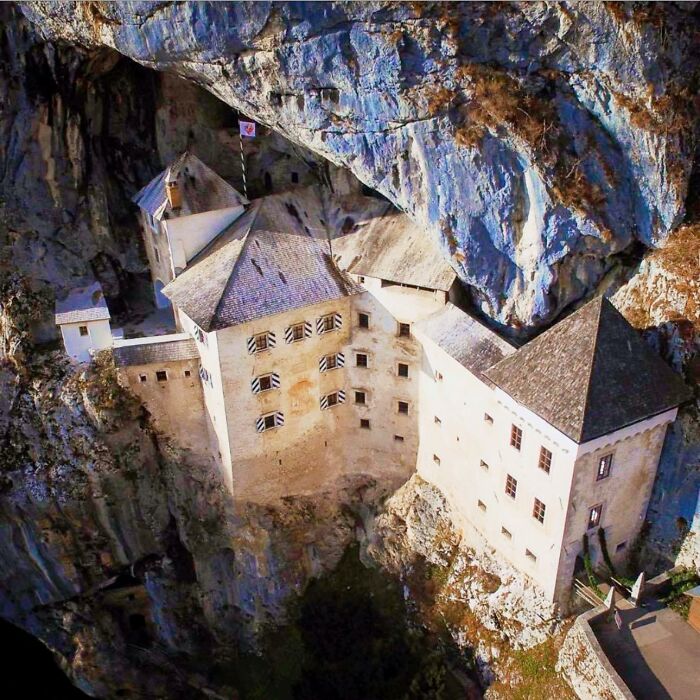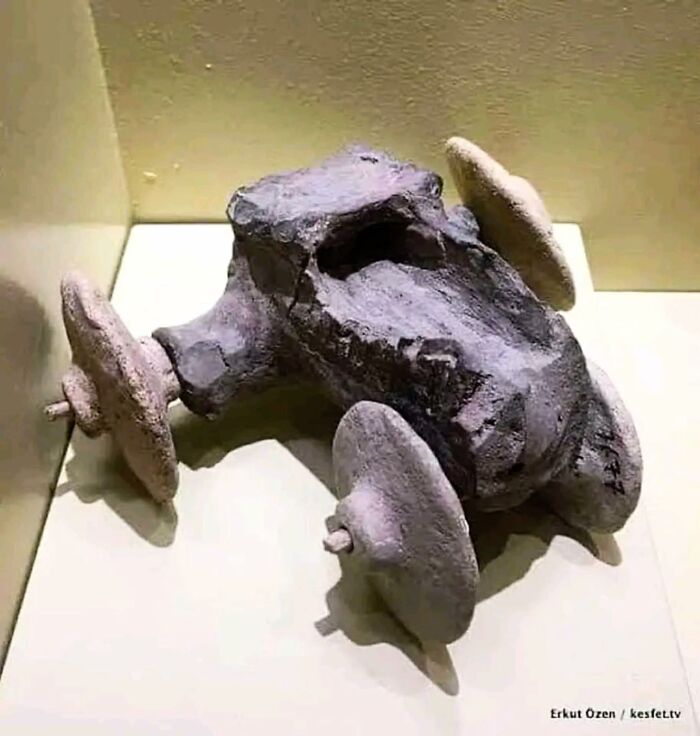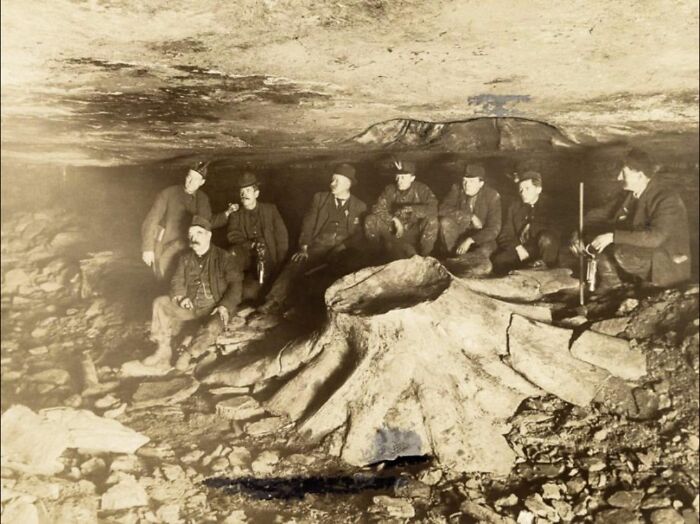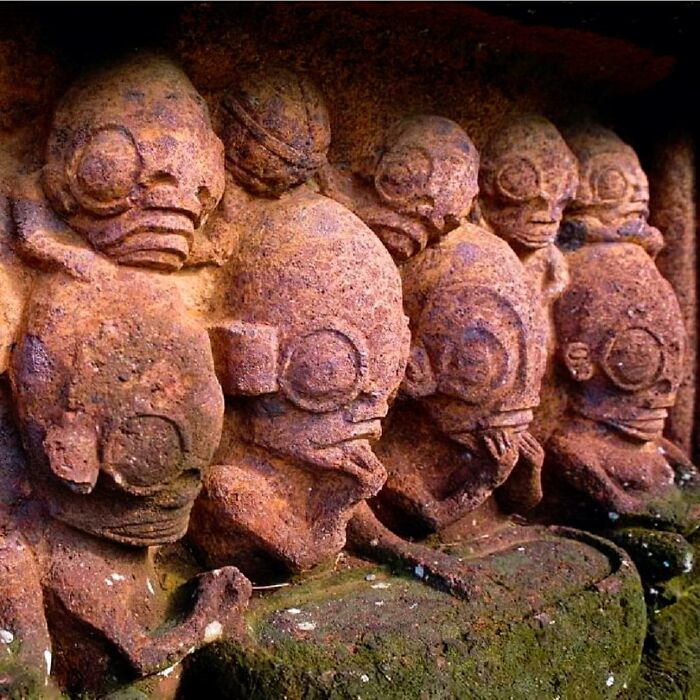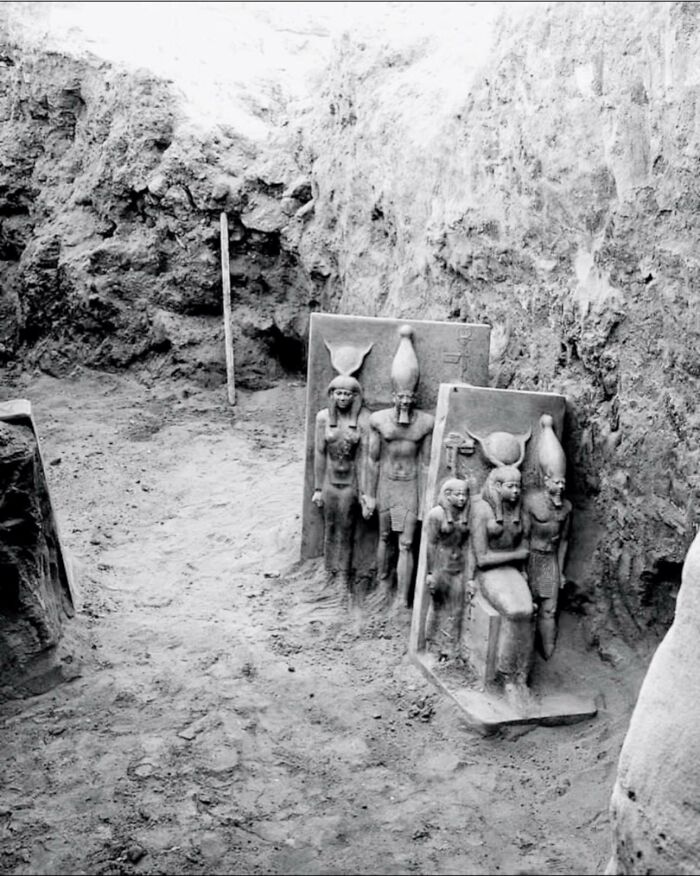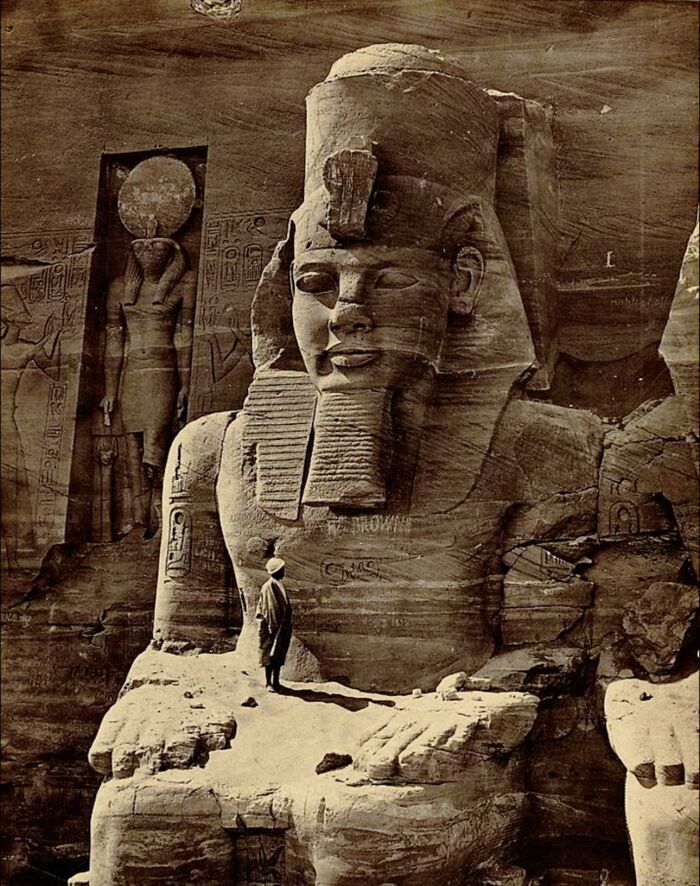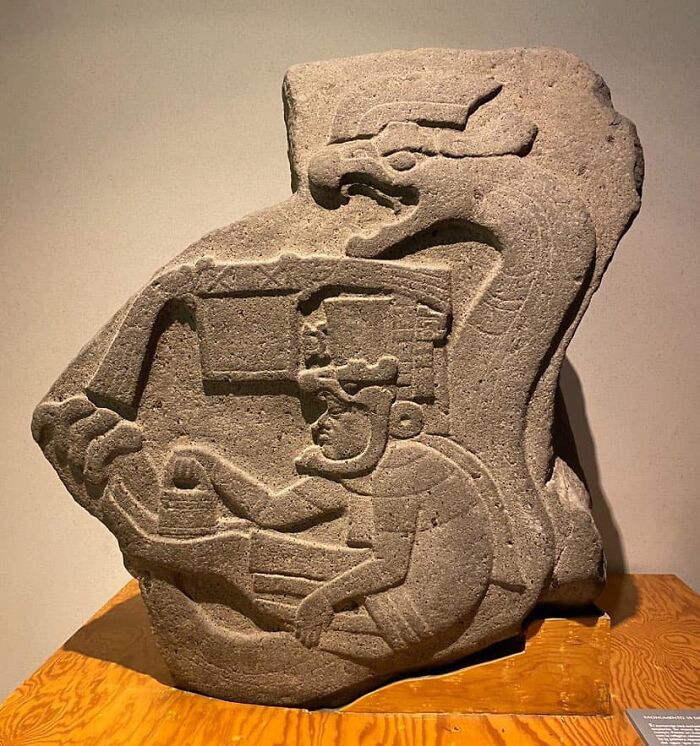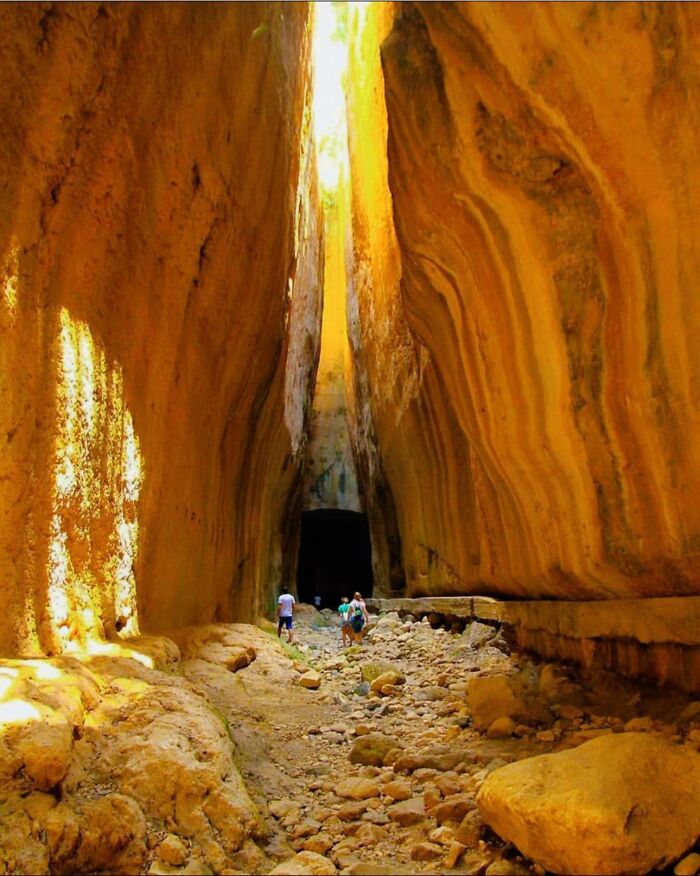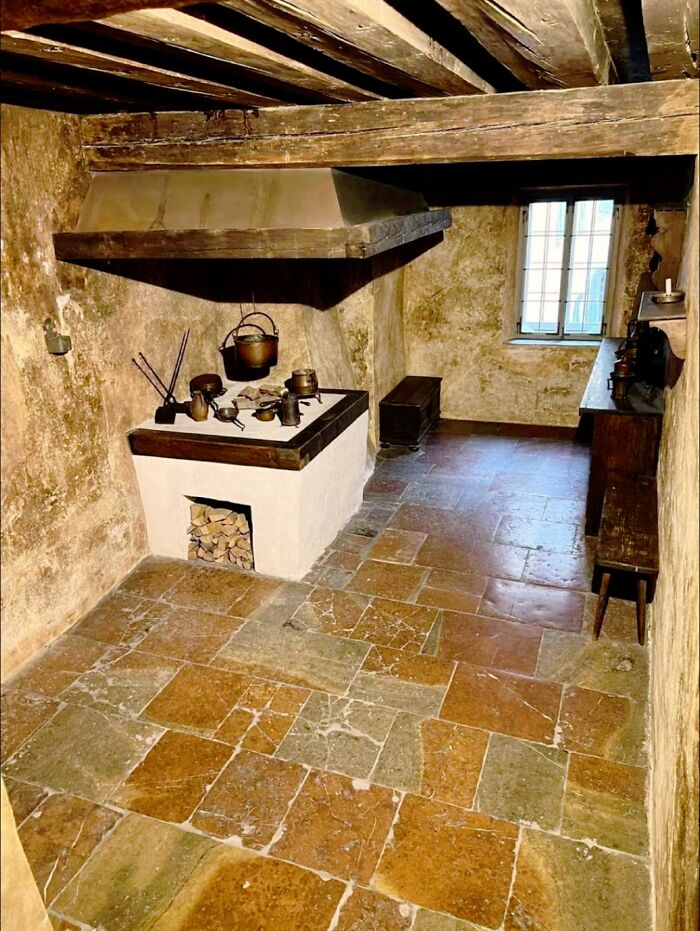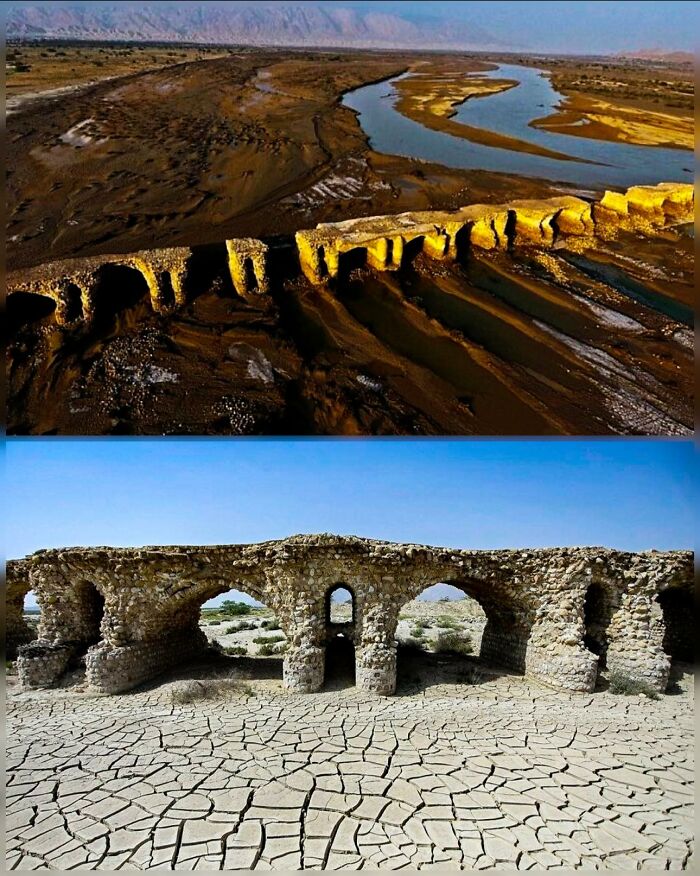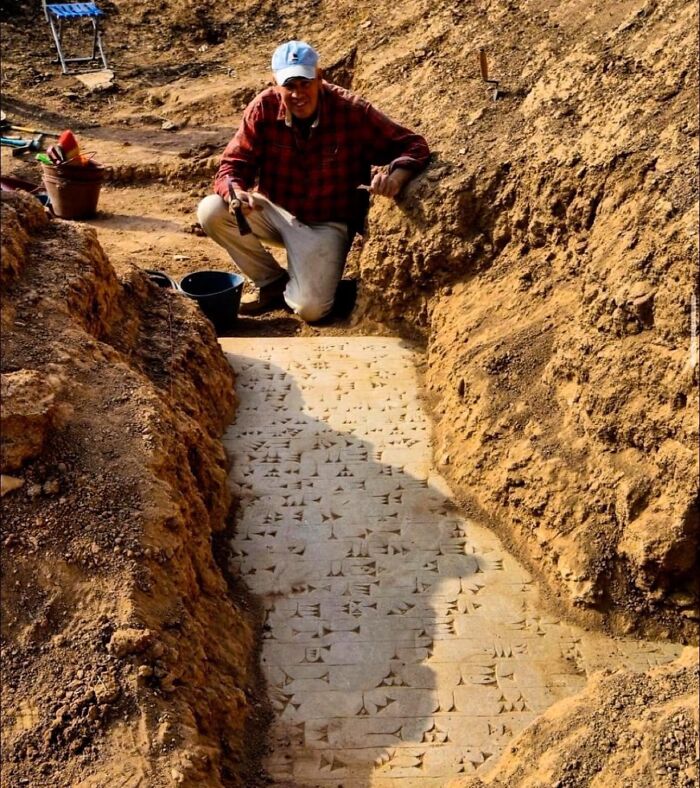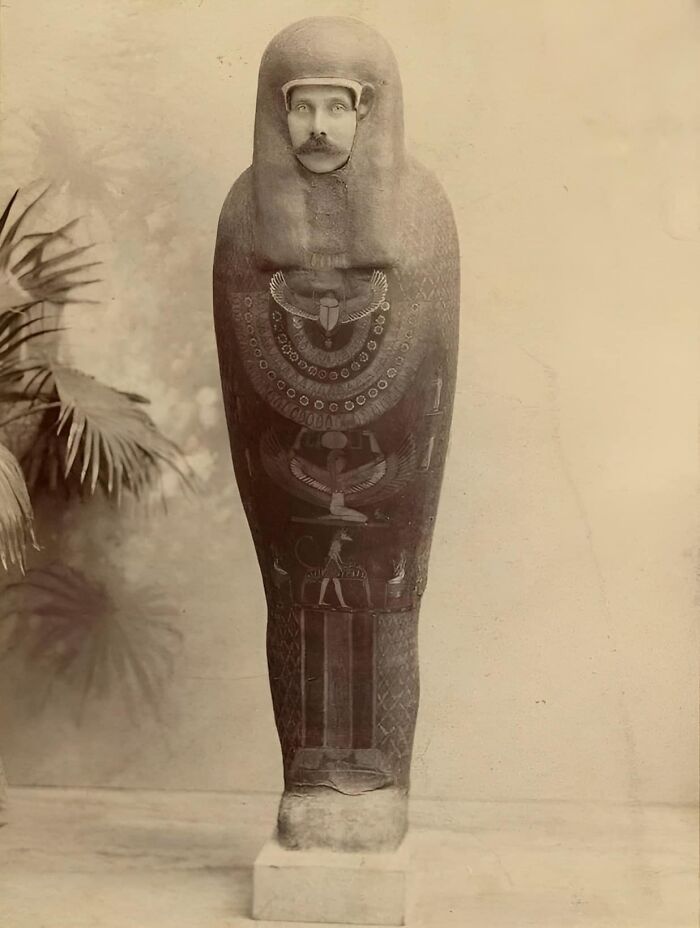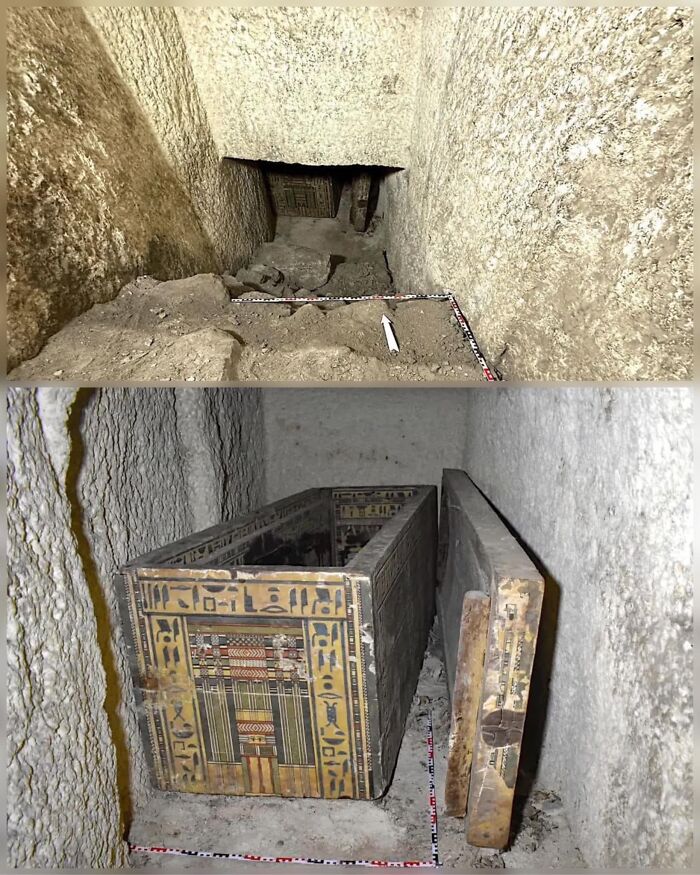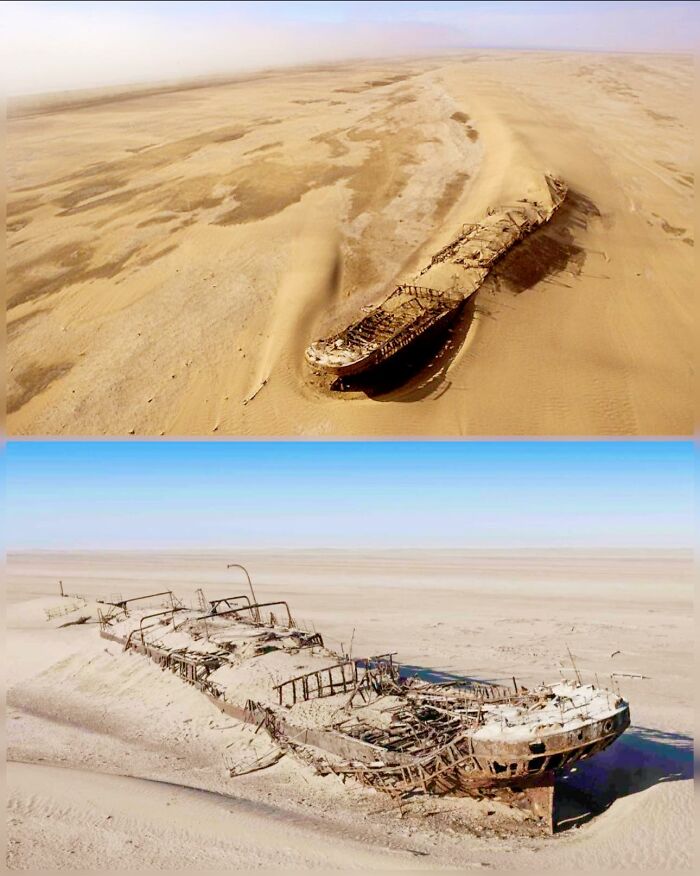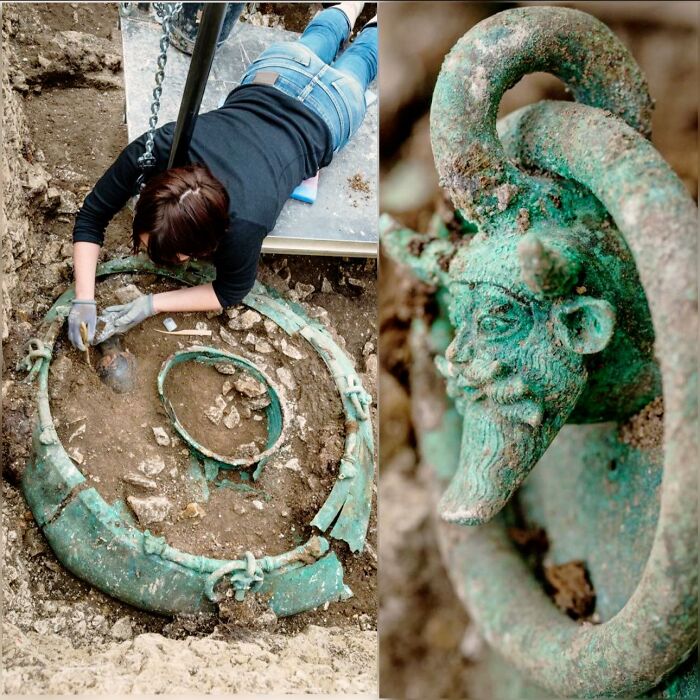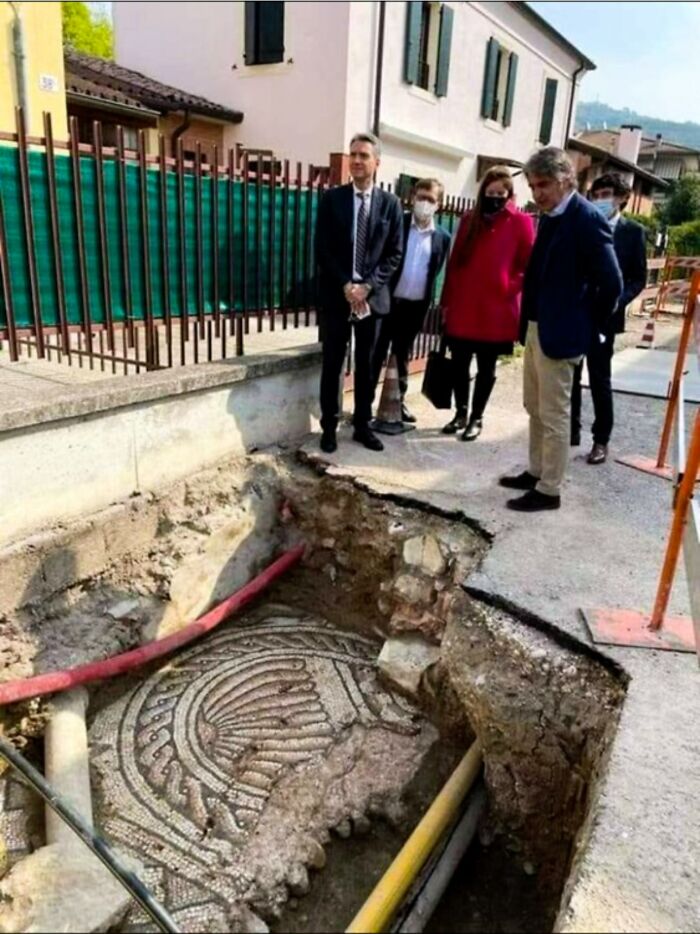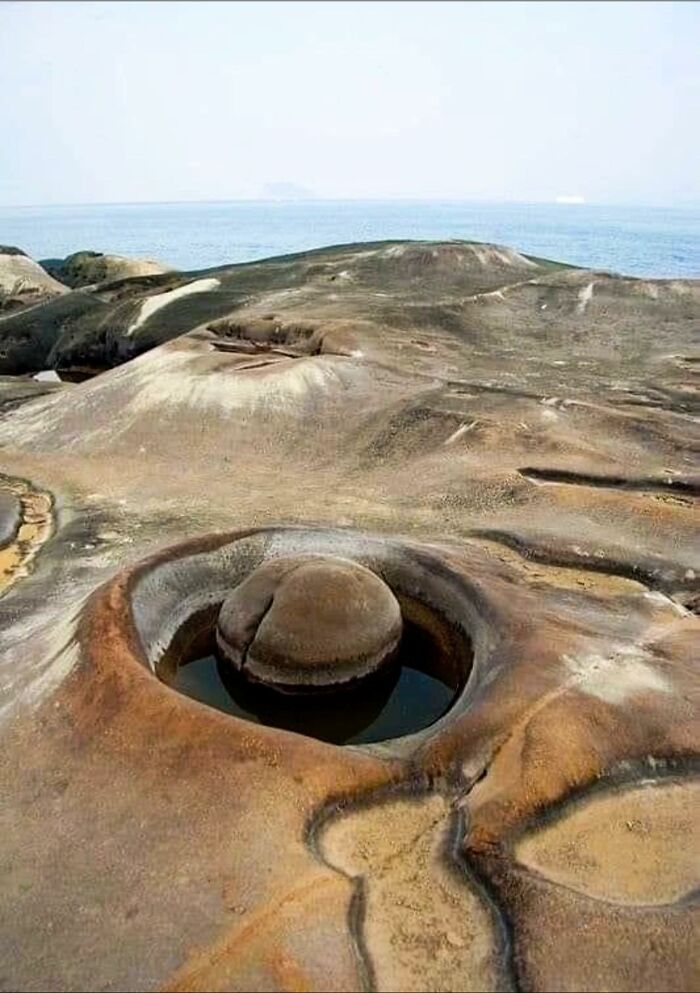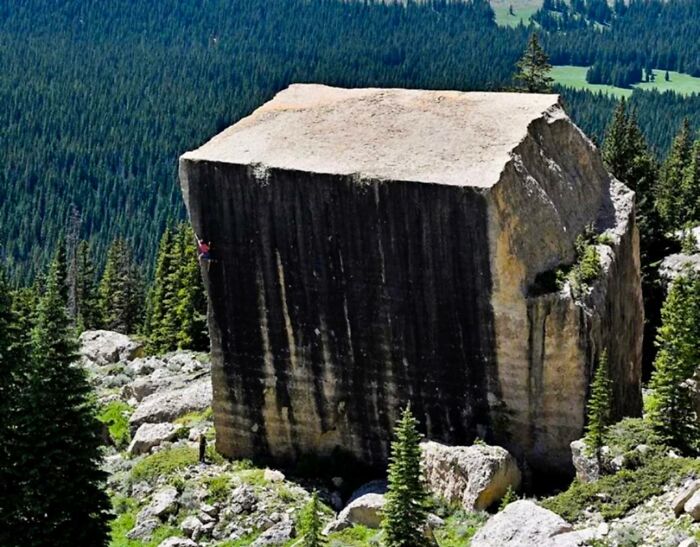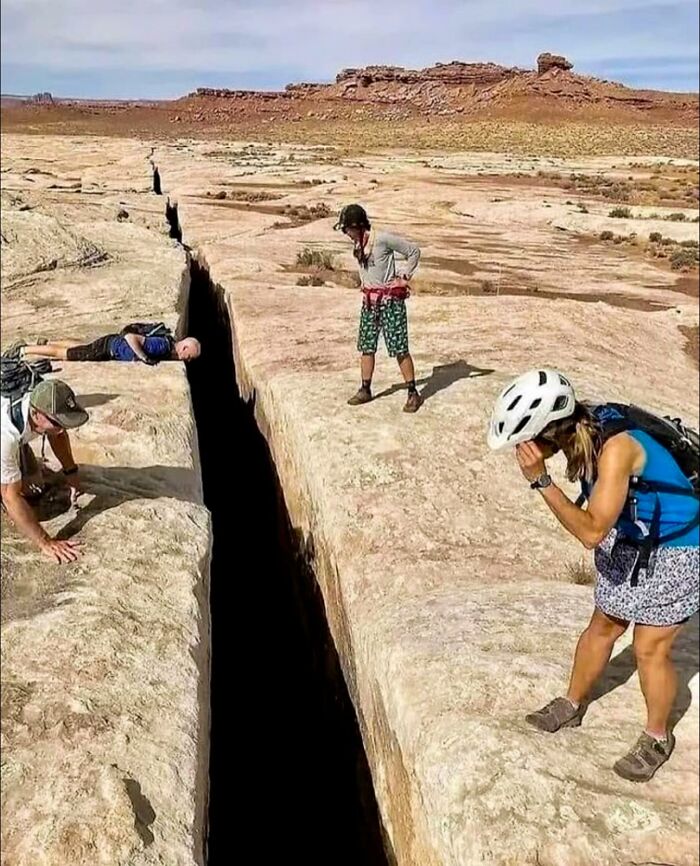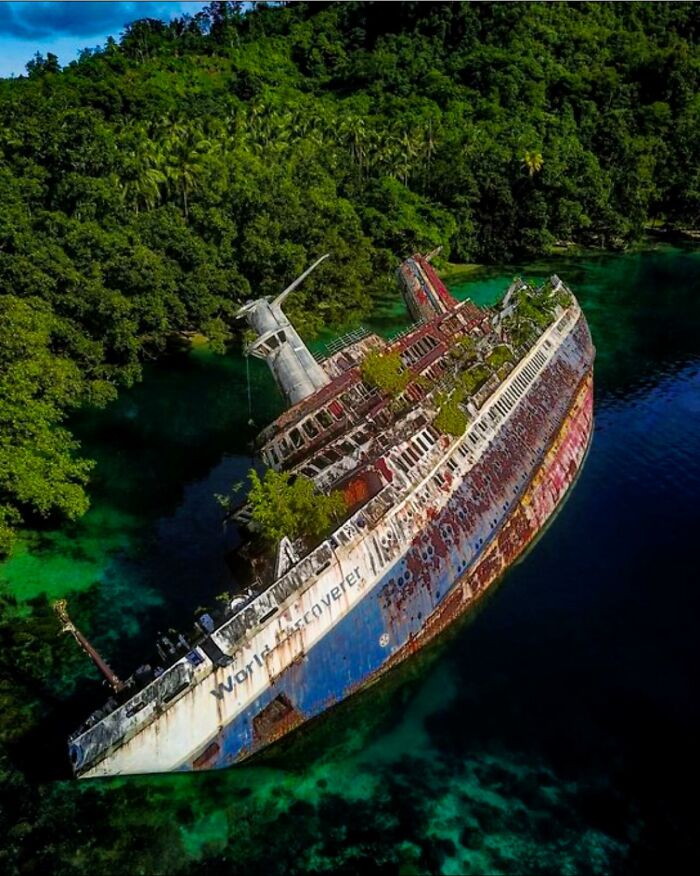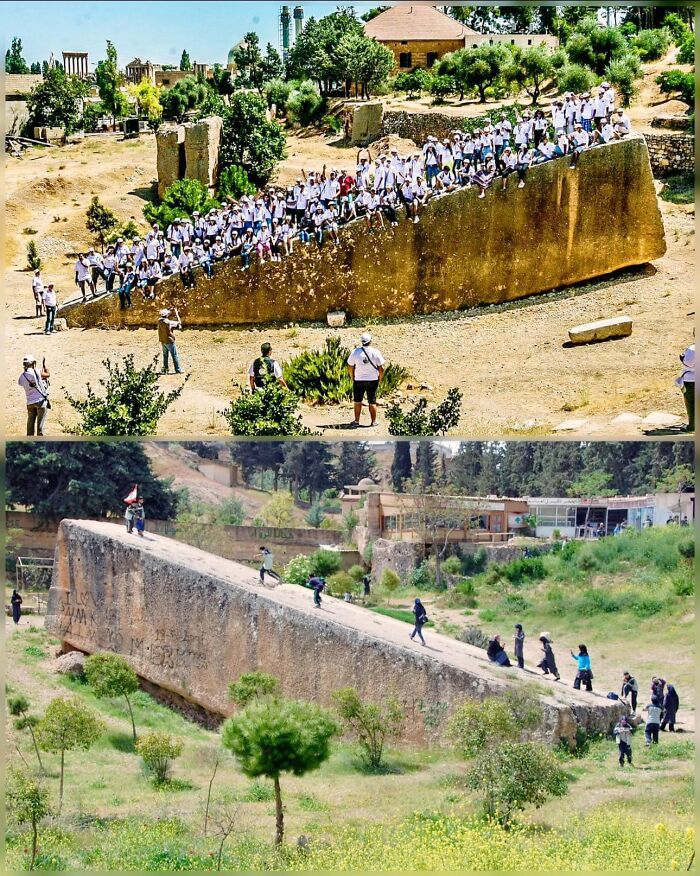In over 4.5 billion years of Earth’s existence and millions of years of human evolution, we’ve seen civilizations rise and fall, survived wars and famines, and made discoveries that have shaped the world we live in.
With so much behind us, it’s no surprise we want to know more about how we got here. To satisfy your (and our) curiosity, we’ve compiled a fascinating collection of photos and facts from the Facebook page ‘History’s Mysteries.’
Scroll down to explore them, and don’t forget to upvote your favorites!
More info: Instagram | YouTube | TikTok
This post may include affiliate links.
This Stunning Masterpiece, Though It Appears To Be Crafted From Crocheted Cotton, Is Actually Sculpted From Marble By The Greek Artist Argiris Rallias
It looks like crocheted cotton that has been dipped in plaster of Paris, and left to dry/set into shape. I'd done this with a spoon.
Load More Replies...At the next annoying family binge you'll have no problems anymore when a little squall abuses the 11-year-old waxed tablecloth as a sail and gently carries Auntie Prosecco's coffee and cake in the direction of her hand-felted funeral dress...🤹🏽 🌬️ 🙅🏽
A Vast Sinkhole Over 290 Meters Deep In Xuanen County, Hubei, China, Housing A Unique Ecosystem Of Ancient Trees, Plants, And Animals
The humid climate and sunlight that reach the bottom create an extraordinary environment that remains largely inaccessible to humans.
Good. Leave it alone. Plants and animals should have some refuge from humans.
"Largely inaccessible to humans." Wait til we find out how to exploit it for natural resources.
Influencers: That sounds like a challenge. Get the cameras, boys. It's Mission Impossible time.
From centuries-old cave paintings to rare historical photos, these posts offer glimpses into the past that you don’t come across every day. Bored Panda reached out to Jonathan Ramsey, the creator behind ‘History’s Mysteries,’ to find out where he discovers all these captivating stories and images, and how he built such a large community.
“I was inspired to start this page out of a deep fascination with ancient history and the mysteries that surround it,” he told us. “I wanted to create a space where people could explore obscure and intriguing stories from the past in a captivating way. The journey so far has been incredibly rewarding, with each post uncovering new insights and building a community of curious minds who share my passion for history.”
One Of The Largest Roman Mosaic Floors Ever Discovered Was Unearthed During The Construction Of A Hotel In Antakya, Turkey
This massive mosaic, dating back to the Roman period, features intricate designs and colorful patterns.
What’s most striking about the find is the unusual rippled effect across its surface, caused by centuries of earth shifting and earthquakes in the region. The result is an impressive, almost wave-like appearance, as if the mosaic were a giant, rippling blanket.
Despite this natural warping, the mosaic has remained remarkably intact, providing a glimpse into ancient Roman artistry and the impact of geological forces over time.
Considering they built aquaducts that had barely any decline but enough for water flow they were gods of leveling.
Load More Replies...It's in a luxury hotel and they've built a walkway over it so you can see it better. Hatay-mosa...5bb527.jpg 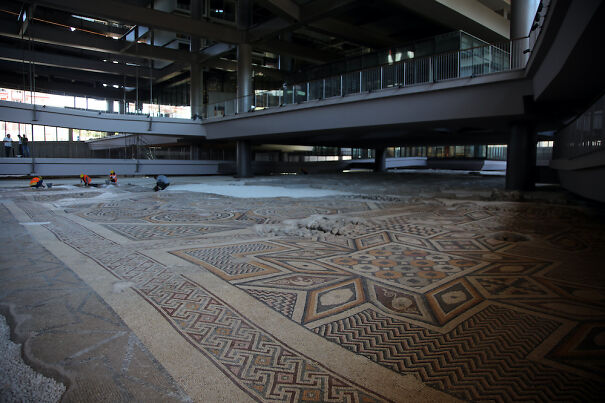
I wonder if it must be preserved now, or hotel building continues 🤔. A nice elevated, glass or perspex floor, to allow viewing would be great (Edited for typo)
Have you seen Stannous's comment, showing the walkway?
Load More Replies...I seen this mosaic before here on BP. But I have always seen it from a above picture and it always looked flat. Nice to see this from a different perspective.
Stunning! If it were found in Las Vegas, they'd just tear it up and build a casino....
Does it? I think the ancient floor is in the hotel, so that's a tourist attraction.
Load More Replies...I wonder if I tear up the carpet in my flat I'll find something like this because the floors sure are rippled. Bought a new office chair because I thought the old one was broken it tilted so much. Nah, it's the floor in that particular spot.
In Turkmenistan, At The Gonur Depe Archaeological Site, A Tomb Dating From 2,400 To 1,600 Bc Revealed Two Intriguing Artifacts
An extremely small golden ram and stone lion. These artifacts, indicative of the precision and craftsmanship of the Oxus civilization, offer a glimpse into the culture and artistic skill of this ancient society.
I'm actually more impressed by the archaeologists that were clearing rubble and didn't either crush these or throw them out because they didn't see them. It makes me wonder if there are other tiny things like this that have been overlooked or crushed over the years.
Amazing these survived and were discovered! Could have been so easily missed.
First glance I thought the fingertip was an elbow in a sweater. Whoah!
Running a page with nearly 500K followers isn’t easy, though. “Researching all these historical facts and photos definitely takes time and effort,” Jonathan shared. “I rely on a combination of academic sources, archaeological reports, historical texts, news outlets, and trusted online databases. I also follow new discoveries and studies in archaeology, which often lead to fascinating material. Social media and community input also play a part, as people share lesser-known stories that sometimes spark new ideas for content.”
Despite how much work goes into finding and researching historical facts, as well as staying up-to-date with relevant news, the result is definitely worth it, Jonathan admitted. “What I enjoy most about this page is seeing people engage with history in a meaningful way,” he said. “Watching the community grow and hearing how certain stories spark their curiosity or make them rethink what they know is really fulfilling. Ultimately, I hope to inspire a broader appreciation for history, shed light on some of the world’s hidden stories, and encourage critical thinking about the past and its impact on the present.”
The Original Star Wars Trilogy Masterfully Used Matte Paintings To Seamlessly Create Vast, Detailed Worlds, Immersing Audiences In Realistic Environments Long Before Digital Effects
OK, I knew about the use of matte paintings, but never suspected them for this particular scene.
Load More Replies...I highly encourage everyone to check out the documentary series "Light & Magic" which covers the history of the Industrial Light & Magic (ILM) effects house. Without ILM, many of the best films of the past 50 years wouldn't be a fraction of what they are. Star wars, Conan, Star Trek, Indiana jones, Jurassic park, T2, The goonies, Never ending story, Labyrinth, The Dark Crystal. Early Pixar films were helmed by ILM (and eventually pixar spun off taking many of the OG effects wizards with them) While they technically didn't create the special effects industry, they are responsible for innovating so many of the tools and techniques that wouldn't even become industry standard for years after introducing them.
All for a few seconds of screen time. Let's hope it didn't end up on the cutting room floor
Star Wars could've been called Space Nazis. I saw the movies, but never really enjoyed them because of this.
Tucked Away In The Historic Cimetière De Laeken In Brussels Lies A Mausoleum That Draws Attention Once A Year For A Truly Remarkable Display
Built in 1920 for Léonce Evrard and his wife, Louise Flignot, the tomb features a solemn sculpture of a mourner, arm outstretched toward a blank wall. However, it’s on the Summer Solstice, when the sun reaches its highest point in the sky, that the mausoleum’s true magic is revealed.
At precisely noon on June 21, sunlight pierces through an opening in the roof, creating a heart-shaped beam of light. This ethereal glow forms for just a few moments, hovering above the mourner’s hand—almost as if the figure is reaching out for this symbolic heart of light.
The phenomenon only lasts for about 15 minutes, but it has captivated visitors for decades, many of whom see it as a romantic testament to enduring love. The heart of light, cast during the longest day of the year, adds an emotional depth to the otherwise somber scene.
Pamukkale, Located In Southwestern Turkey, Is One Of The World’s Most Stunning Natural Wonders
Its name means “Cotton Castle” in Turkish, a fitting description for its surreal white terraces formed by the deposition of calcium carbonate from hot spring waters.
These terraces, filled with mineral-rich waters, cascade down the hillside, creating a visual spectacle of snow-white pools glistening in the sun. Pamukkale has been revered for its therapeutic qualities since antiquity.
The ancient city of Hierapolis was built adjacent to the site by the Greeks in the 2nd century BC, serving as both a healing center and a major cultural hub. People would travel from across the ancient world to bathe in the warm waters, believing them to have miraculous healing powers.
Today, Pamukkale is a UNESCO World Heritage site, combining natural beauty with historical significance. Visitors can still explore the ruins of Hierapolis and dip their feet into the same pools that were cherished thousands of years ago.
That these are such pure white is amazing. Here are some similar formations in (clockwise) Haung Long, China, Yellowstone National Park, and Carlsbad Caverns NP. Huang-Long...797e89.jpg 
I've been to Pamukkale as a child 30 years ago and if I remember correctly, the pools didn't look as white back then because everyone was just going in there bathing. It was slowly destroying the pools, so they forbid entering of any kind some years ago. Seems like it worked and the terraces were able to recover. :) It was still one of the most beautiful places I've ever seen in my life, even in it's worst state.
Load More Replies...Not any more! What a mess the place is in now. I think it was caused by mis-managing the water system.
I'm content to look at it in pictures and not risk damaging such a stunning place by being a tourist.
A trip to Turkey to see this and the stunning floor in the previous one
I am so desperate to get to Hieropolis and Pumakkale!! It’s been high up there, but after Istanbul was so incredible, my interest has skyrocketed!
Istanbul is my favorite place to visit but I loved traveling along the western and southern borders. I still have the interior and Cappadocia to visit. While it's hard to leave Istanbul, it's so worth it.
Load More Replies...Jonathan likely doesn’t have to worry about his followers losing interest in history anytime soon. According to a 2020 survey by Conner Prairie, 96 percent of people in the U.S. believe it’s important to look at history to inform the future. Additionally, 91 percent agree that learning about history helps build a strong foundation for what’s ahead. In fact, 42 percent of Americans report a higher level of curiosity about history compared to the previous year.
Clearly, enthusiasm for the past is on the rise. That’s why it’s great that Jonathan, along with his page and many other corners of the internet, is doing such a fantastic job of giving us exactly what we crave: fun, riveting nuggets of history that expand our knowledge and help us appreciate everything that came before us.
A Woman From The 1950s Stands Beside A Towering Redwood Tree
Redwood trees, among the tallest and oldest living organisms on Earth, dominate the coastal forests of Northern California. These majestic giants can reach heights of over 350 feet and live for more than 2,000 years, showcasing a resilience that has captivated nature lovers for centuries.
Their thick, reddish-brown bark is not only visually striking but also serves as a protective layer against pests and fire. The unique ecosystem they create supports diverse wildlife, from towering canopies filled with birds to the rich undergrowth teeming with life. As symbols of endurance and beauty, redwoods remind us of the importance of conservation and our connection to nature.
Without a banana in the photo, I can’t really wrap my mind around the scale.
Load More Replies...Can't believe people thought "These trees are so majestic. Let's cut them all down"
The wood is very rot resistant like its cousin cedar. They are both from the cypress family.
Load More Replies...Fun fact: due to the laws of physics and hydrodynamics, the tallest any tree can grow is approximately 426 feet. So these trees are almost as big as any tree can get (vertically).
IIRC there are redwoods that have actual freeways running through their bases. They’re enormous
https://external-content.duckduckgo.com/iu/?u=https%3A%2F%2Ftse1.mm.bing.net%2Fth%3Fid%3DOIP.2HeGlBux3hwD2gv5907liQHaE8%26pid%3DApi&f=1&ipt=4ba9efb843ef0aaa985692da7c4f1b4f691e093f509f8e8e44e246a532194cd0&ipo=images
Load More Replies...There are now more Giant Redwoods in the UK than in California. But the UK ones still babies in comparison. .
The Oldest Recorded Evidence Of Honey Collecting, Found In The Cuevas De La Araña Near Bicorp, Spain, Is Estimated To Be Between 8,000 To 10,000 Years Old
This Mesolithic cave painting depicts a person climbing to reach a wild bees' nest, with bees flying around and honeycombs visible, providing early documentation of human honey harvesting activities.
The painter went like: "body, wings, legs, body, wings, legs, body, wings... you know what? Wings, wings, wings, close enough."
Jimbacrinus Crinoid Fossils From Gascoyne Junction, Western Australia, Offer A Rare Glimpse Into Life 250 Million Years Ago
These ancient sea creatures, with their stem-like bodies and feathery arms, once thrived in shallow waters.
Their stunning preservation reveals a rich marine ecosystem that existed before the devastating Permian extinction, when massive volcanic eruptions, global warming, and ocean acidification wiped out nearly 90% of marine species.
These fossils help unlock the mysteries of Earth’s deep history and the dramatic changes that followed this catastrophic event.
Crinoids still exist. They're called sea lilies and live in the deep ocean.
The Lion-Man, Carved From Mammoth Ivory Roughly 38,000 Years Ago, Stands As The Oldest Known Example Of Figurative Art
Discovered in a cave in Germany, this enigmatic sculpture merges human and animal features in a way that challenges understanding—both hauntingly familiar and strikingly otherworldly. It offers a profound glimpse into the creative genius of early humans, hinting at their capacity for imagination and symbolic thought.
Remarkably, the Lion-man predates the advent of known written language by more than 30,000 years. To put that in perspective, it is older than Stonehenge by tens of thousands of years. This ancient artifact showcases an extraordinary leap in artistic expression, marking one of the earliest examples of humans conveying complex ideas long before written records existed
Think about that. That person knew what a lion (or the local puma variant) looked like, then killed a mammoth, in germany, and carved that art out of the tooth of it. 38,000 years ago.
The european lion went extinct around the first century BC. Most of the lions in Roman arena were European, not African.
Load More Replies...Not impossible - but then: it is "only" a human body with an animal head. Striking in its artfulness, but in effect merging/combining two beings that people back then were very much used to seeing and dealing with. I think the idea itself popped up thousands if not millions of times independently, even back then.
Load More Replies...Sir David Attenborough Is Pictured With A Colossal Thigh Bone From A Titanosaur, One Of The Largest Dinosaurs Ever To Walk The Earth
In 2013, a shepherd in Argentina’s Chubut Province made a remarkable discovery on La Flecha farm, spotting the tip of a massive fossil bone protruding from the ground.
This led to an excavation by paleontologists, who uncovered the 2.4-meter (8-foot) femur, along with over 220 bones from at least seven titanosaur individuals. The dinosaur, estimated to be 37 meters long and weighing around 70 tonnes, is believed to have lived approximately 100 million years ago, making it the largest known species to have ever existed.
My wife, hearing him narrate a show on PBS or History Channel, said "why are you watching Winnie the Pooh?" She ain't wrong.
Load More Replies...David Attenborough has to one of the all time greats of television, I don't think anyone has even come close to his narration of documentaries.
Maybe James Burke, with his various 'Connections' documentary series, as well as 'The Day the Universe Changed'.
Load More Replies...Such a shame that Attenborough was one of those that flew around the world smoking as he went and now wants to refuse us the pleasures of doing the same thing, ( Flying, not smoking)
From now on, we do 'Needs Sir David Attenborough for scale', agreed? - (Susical gets it!)
I had my photo taken with the same or similar in the museum at Trelew, Chubut, Argentina.
With David Attenborough or someone similar? /sorry, joking!
Load More Replies...Upper leg bone, between hip and knee. Titanosaur is one of the many "longneck" sauropod dinosaurs.
Load More Replies...In The Arid Expanse Of Wadi Al Hitan, An Egyptian Desert Region, A 37-Million-Year-Old Whale Skeleton Has Been Uncovered
This site, known as the Valley of the Whales, has revealed dozens of rare fossilized whale skeletons, offering invaluable insights into prehistoric marine life.
To safeguard these remarkable discoveries and promote their study, a dedicated museum has been established at the site. This museum not only helps preserve the fossils but also serves as an educational hub, shedding light on the evolutionary history of whales and the ancient environments they inhabited
The elusive "sand-whale" of antiquity has been discovered at long last.
I love big skeletons! We don’t see many organisms bigger than us these days…that’s why I love dinosaurs, too!
Over 9,000 Years Ago, When The Sahara Was A Thriving Savanna, Ancient Artists Carved A Remarkable Scene Into The Rocks Of What Is Now Niger’s Desert
Hidden in the Aïr Mountains, the Dabous giraffe carvings stand as a testament to a time when this vast desert was full of life.
These carvings depict two life-sized giraffes, with one led by a human figure, capturing a moment of interaction between man and nature. Each giraffe, stretching over 18 feet in length, was etched with care, reflecting the importance of these animals to the people of that era.
Today, the Dabous carvings are considered some of the most significant prehistoric rock art in Africa, offering a rare glimpse into a world long lost to the desert sands. They remind us that the Sahara, now barren, was once a green and vibrant landscape, alive with both humans and wildlife
I sort of knew the Sahara region was not a completely barren desert back then. But I did not expect it was this recent. Recent enough for modern humans to exist and thrive there.
One theory is that the fall of Eden in some way recalls the desertification of north Africa and the Middle East. As an incredibly vast Savannah, it would've been an ideal habitat for early farmers. (Modern Savannahs are typically known as breadbaskets, such as in the Central United States, Argentina, Ukraine, etc.)
Load More Replies...OK, who has a handy Sir David Attenborough so we know how big this is?
So cool.. Whoever discovered these definitely thought, "nobody is going to believe me".
No doubt all the forests were cut down to feed Yorkshires environmentally friendly Drax power station.
A Fully Unearthed Moai Statue On Easter Island
The Easter Island statues are iconic monolithic human figures carved by the Rapa Nui people on Easter Island in eastern Polynesia between the years 1250AD and 1500AD. They are believed to represent ancestors and were placed on ceremonial platforms called Ahu. The construction and transportation of these massive statues, some weighing up to 80 tons, remain a subject of fascination and study due to the island's remote location and the engineering feats involved.
Yes,and the bodies were buried underground. At ground level we only see their heads and part of their shoulders.
Load More Replies...I grew up thinking that modern humans were so much more advanced than ancient humans. I love seeing things that ancient humans created/ built that we don't fully understand
I love the saying, "People in the past were just as smart as people today. People in the past were also just as stupid as people today."
Load More Replies...Viking Ice Skates Dating Back To The 10th Century Ad; Made Of Leather And Horse Bone
I have only seen viking age skates with holes drilled through for leather straps so you could attach the skate to your normal shoe. I've never seen these skates with a special shoe attached. Of course, I've not seen all viking age skates so perhaps the ones I saw at the National Museum of Denmark was the low-end ones?
Petrified Forest National Park, Located In Northeastern Arizona, Is A Stunning Landscape Filled With Ancient Fossilized Trees, Colorful Desert Vistas, And Unique Geological Formations
The park covers about 346 square miles and preserves one of the world’s largest concentrations of petrified wood, some dating back over 225 million years to the Late Triassic period.
The petrified wood found here once belonged to massive conifer trees that grew in lush river ecosystems. Over time, volcanic ash buried the fallen trees, and minerals like quartz slowly replaced the organic material, turning them into stone. These colorful logs shimmer in hues of red, orange, and purple, scattered throughout the park
Enhanced. Not actually that bright, having been there.
Load More Replies...all of filters used in that pic...the trees are cool looking, but not that cool looking
I have been to this park and never saw anything this colorful there (but saw plenty of petrified wood). Was this one polished up to demonstrate what they could look like? Everything I saw was covered in dust and the colors were pretty dull (like the stones on the ground)
Mary Smith, A Famous London Knocker-Upper Who Earned Six Pence A Week Per Client By Waking Them With A Pea Shooter That Tapped On Their Windows
This unique service was essential in the early 20th century, before alarm clocks became widely available.
Who woke up the knocker-upper? How did they get up on time? Does anyone know?
They worked shifts, the last person she woke up did the night shift, and so on, if BP put full article in it make sense but they just want views and comments
Load More Replies...It wasn't a 'unique' service. There were many knocker-uppers working in industrial towns and cities, employing various techniques from pea-shooters and throwing pebbles to knocking on their clients' bedroom windows with long sticks. The one thing they didn't do was bang on doors, because that risked waking neighbours who would otherwise have to pay for the service.
The most interesting thing about this is how many people wanted a woman to come around and knock them up.
4,000 Year Old Chinese Ceramic Water Pipes Discovered At The Pingliangtai Archaeological Site In The Central Plains Of China
Utilizing advanced engineering and urban planning, these Neolithic people effectively managed water flow and prevented flooding in the ancient settlement.
It's amazing that they used ceramic, rather than the much more common (in Europe) lead pipes, which we know (as they did) causes health issues.
Im thinking it might be due to that time era, either they didnt have lead, or maybe lead was not widely available yet, or they did not have the capacity to melt lead,...
Load More Replies...What are "drainage pipes?" I bet they would go down a treat in Scotland.
The Stone Age lasted until different dates in different places. One of the numerous ways of defining the Neolithic period is the use of polished stone tools, which persists in some places right through to today.
Load More Replies...In The Heart Of Hattusa, The Former Capital Of The Hittite Empire In Modern-Day Turkey, Lies A Mysterious Green Stone, Believed To Be Made Of Serpentinite
This stone, housed in the temple complex, likely played a crucial role in Hittite religious practices before the city's destruction around 1200 BC. Its exact purpose remains unknown, adding to the intrigue that surrounds this ancient relic.
And for the ancient Greeks this may have turned into Gaia's navel stone (which some mythologists locate at Delphi anyway)...🪨
It's not "some mythologists." Archaeologists and historians agree that a large number of ancient Greeks thought the navel of the world was in Delphi. Having the actual navel helps with the determination.
Load More Replies...The Bison Sculptures Found In The Le Tuc D’audoubert Cave In Ariège, France
Extraordinary examples of prehistoric art, estimated to be around 14,000 years old. Dating back to the Upper Paleolithic period, specifically the Magdalenian culture, these sculptures depict two bison and are remarkable for their detail and realism.
Discovered in 1912 by the three teenage sons of the French count Henri Begouën, the sculptures have been well-preserved due to the cave’s stable environment. Crafted in high relief from clay, the bison showcase the skill and artistic ability of prehistoric humans. The artists used their hands, fingernails, and simple tools to shape the clay, creating lifelike textures and details such as fur and muscle structure.
Niagara Falls As A Breathtaking Spectacle Of Ice In The Early 1900s, Showcasing One Of The Rare Times It Has Frozen Over
I do have a postcard showing Niagara Falls completely frozen over. And it is much more recent than this. I'd say in the 1980's - to 1990's.
The only time the falls has completely frozen over was 1848. Since then only sections of the falls have partially frozen over (even in the picture above you can see that water continues to flow)
Load More Replies...Truly beautiful to see when iced over and the various colourful spotlights are played over them
In 2021, Archaeologists In Sbeitla, Tunisia, The Ancient City Of Sofitola, Uncovered A 1,500-Year-Old Byzantine Bathtub
Made from stone, this tub exemplifies the region’s advanced craftsmanship and the luxurious lifestyle during the Byzantine period. The discovery provides insight into the wealth and sophistication of the city, revealing how even provincial towns like Sbeitla embraced high standards of architecture and infrastructure.
Bruce Mccandless Made History As The First Human To Float Freely In Space Without Any Tether To A Spacecraft
On February 7, 1984, during the STS-41-B mission, he ventured into the vast expanse equipped only with his Manned Maneuvering Unit (MMU), a jetpack-like device that allowed him to navigate in zero gravity. Drifting away from the safety of the space shuttle Challenger, McCandless became a solitary figure against the backdrop of the cosmos, relying solely on the MMU's thrusters to control his movements.
This daring maneuver was more than a technical achievement; it symbolized the human drive to explore the unknown and push the boundaries of space travel. McCandless’s untethered spacewalk remains an iconic moment, showcasing both the bravery of astronauts and the remarkable advancements in space technology that made such feats possible.
While it is an amazing achievement and photo... I have to say... Aw hell naw...
Those astronauts trying out a new technology that their life depends on must have amazing mental skills for managing anxiety.
have to wonder how he fit his enormous brass balls into his spacesuit?
Nooooo thank you. Super cool, but no way I'd be brave enough for that lol.
This Illustration Is An 18th-Century Depiction Of A Once-Common Belief That Toothaches Were Caused By Small, Demonic Creatures Known As "Tooth Worms"
In this folklore, the tooth worm was imagined as a malevolent entity burrowing into teeth, causing decay and pain. Before modern dentistry, people believed that the writhing of these worms within the tooth was the source of excruciating discomfort.
The concept dates back to ancient civilizations, but it endured well into the 18th century. Artists often portrayed the tooth worm as a demon from hell, adding to the fear and mystery surrounding dental ailments in a time when treatment was rudimentary and pain was inescapable.
Any northern European child knows that Karius and Baktus causes tooth decay, not a worm.
In April 2016, Construction Workers In Tomares, A Suburb Of Seville, Spain, Made A Serendipitous Discovery While Installing Electricity In El Zaudín Public Park
Using a mechanical digger, they unearthed a remarkable trove of Roman coins hidden in 19 large ceramic amphorae, buried about a meter underground. While the digger damaged 10 of the amphorae, nine remained intact and sealed. This hoard, weighing over 1,300 pounds and containing more than 50,000 bronze coins from the late third and early fourth centuries AD, was concealed with bricks and ceramic filler.
The workers halted their project and alerted authorities, prompting an excavation by archaeologists. By November 2022, experts from the University of Seville had completed their analysis, confirming the find as the largest Roman coin hoard ever discovered in Spain. This extraordinary cache provides invaluable insights into Roman economic history and highlights the strategic measures taken to safeguard wealth during that era.
Of course not. They had to go to the laundromat somehow 😁
Load More Replies...The country of Spain will keep it as an archeological find. The value is in its history, not necessarily monetarily. To quote a famous archeologist, "It belongs in a museum!"
Load More Replies...Houtouwan, Once A Thriving Fishing Village On Shengshan Island Off The Coast Of China, Is Now A Remarkable Example Of Nature Reclaiming Human Spaces
Abandoned in the 1990s due to its remote location and difficulty in accessing resources, the village’s stone houses are now completely overrun with thick green vegetation. Ivy and creeping plants have consumed the walls and roofs, creating a hauntingly beautiful landscape where the remnants of human life are barely discernible beneath layers of greenery.
I fear the day when Kudzu cross-breeds with Bamboo.
Load More Replies..."And Spring herself, when she woke at dawn, would scarcely know that we were gone." Sara Teasdale, "There Will Come Soft Rains"
There is not such thing as "human space, we are temporary inhabitants, not owners of anything.
Underground Caves Lined With Millions Of Shells, And No One Knows Who Built Them
The Shell Grotto in Margate, Kent, England, stands as one of history’s most baffling mysteries. Discovered in 1835, this hidden passageway is adorned with over 4.6 million meticulously arranged shells, forming elaborate mosaics that cover every inch of its walls and ceilings. The designs are precise and intricate, depicting symbols, patterns, and figures whose meanings remain shrouded in mystery.
What makes the grotto so compelling is that no one knows who created it, when, or why. Some speculate it dates back to ancient times, possibly as far as the Roman or Phoenician period, while others believe it was constructed in the medieval era or even the 18th or 19th century by an eccentric individual. Was it a secret temple, a meeting place for a hidden society, or a mysterious art project? Theories are abundant, but definitive answers are nonexistent. The Shell Grotto is more than just a stunning piece of craftsmanship; it’s a riddle that continues to confound experts and captivate visitors from around the world.
Probably was some bored retiree that had boxes of seashells from holiday and an old passageway in need of sprucing up.
I’ve always wondered if some of the discoveries we’ve made are more simple than we think 😂 I once sculpted a crude little man out of clay at a summer camp, and gave him a little clay baseball hat. I was just playing around and he doesn’t mean anything, but imagining historians finding it 3,000 years from now and trying to decipher the meaning of the baseball hat is kind of hilarious. “It’s a crown, this must be an ancient king!”
Load More Replies...Couldn't the shells be dated to give a rough idea of when it was finished?
Dating the shells would give you their age, not when they were used for construction.
Load More Replies...We at least know that if it was built it's not a cave. Even if it is underground.
Shoichi Yokoi Was A Japanese Soldier Who Hid In The Jungles Of Guam For 27 Years After World War II Ended, Unaware That The War Was Over
He avoided capture out of fear and loyalty to the Imperial Japanese Army’s orders to never surrender.
Yokoi was discovered in January 1972 and returned to Japan in February of that year. Upon his return, he was overcome with emotion and wept, as it was his first time back in Japan since the war.
"He had known since 1952 that World War II had ended[6][7] but feared coming out of hiding, explaining: "We Japanese soldiers were told to prefer death to the disgrace of getting captured alive." Wikipedia
He probably wondered where all the amazing 7-11 stores came from once he was back in civilization...and WTF was this weird anime stuff?
Once A Lavish Roman Resort Located On The Northwest Shore Of The Gulf Of Naples, Baiae Was The Playground Of Emperors Like Nero And Julius Caesar, Famed For Its Opulent Villas, Hot Springs, And Scandalous Reputation
Known for corruption and excess, it was a place where Rome’s elite indulged in debauchery and political schemes.
However, the same volcanic activity that powered its famous hot springs ultimately sealed its fate. Due to a process called bradyseism, the land slowly sank from volcanic activity beneath the surface, causing much of the city to gradually submerge, taking its grandeur with it beneath the waves.
The Maras Salt Mines, Located In Peru's Sacred Valley, Are An Ancient Site Where Salt Has Been Harvested For Over 2,000 Years
These mines consist of over 5,000 small, terraced salt pans that stretch across a mountainside. The salt is collected from a natural underground stream that fills the pans with mineral-rich water. As the water evaporates in the sun, it leaves behind salt crystals.
The history of the Maras salt mines dates back to before the Inca Empire, making them one of the oldest known salt production sites in the world. The Incas took control of the mines and used the salt as a key resource for trade and preservation. Remarkably, the traditional methods of salt harvesting at Maras have been preserved and are still used today by local families.
These salt mines are not only a significant historical site but also a living part of the local culture, where ancient practices continue in the modern world. The Maras salt mines offer a unique glimpse into the past, showing how ancient civilizations utilized natural resources in ways that remain relevant today.
Europe’s Oldest Known Road Lies On The Island Of Crete, A Remarkable Engineering Feat Over 3,500 Years Old
This Minoan road spans roughly 50 kilometers, connecting the ancient city of Knossos with Gortyn and Lebena.
What makes this road so extraordinary is its advanced construction. It features side drains to manage water runoff, which helped preserve the road over millennia. The roadbed is composed of a 20-centimeter-thick pavement of sandstone blocks, tightly fitted and bound with a durable clay-gypsum mortar.
On top of this foundation, a layer of basaltic flagstones was laid to provide a smooth, hard-wearing surface. The inclusion of separate shoulders, which were uncommon for the time, demonstrates a sophisticated understanding of road design, ensuring safe and efficient travel.
Petra Theater, Constructed During The 1st Century Ad In Petra, Jordan, Exemplifies The Advanced Engineering And Architectural Prowess Of The Nabataeans
This impressive structure features a semi-circular auditorium meticulously carved out of the local sandstone, with the seating area divided into three horizontal tiers, separated by broad passageways and accessible via seven stairways.
The theater's stage and external walls, built from dressed stone, complement the rock-carved auditorium. With a capacity of up to 3,000 spectators, Petra Theater was a central venue for public performances and gatherings, reflecting the cultural and social significance of the Nabataean civilization.
The theater's integration of rock-cut and constructed elements highlights the innovative blend of natural and man-made materials, showcasing the Nabataeans' exceptional architectural skill.
wait, wait. whenever they show you pictures of petra, they show you pictures of the treasury... when there was this AMPHITHEATER there the entire time??? why have I never seen a photo of this before???
Probably due to Indiana Jones movies. Also, the theater is very similar to a large number of other ancient theaters.. Every Greco-Roman city would have one and there are some still in use today. The larger the city, the large the theater. Epidarus was the most impressive for how quiet a person could speak on stage and the acoustics made it easy to hear
Load More Replies...Wasnt't familiar with the Nataeans, which is odd since they were the neighbors of the three Israeli states (Galilee, Judea, Samaria), wraping around from the Northeast, to the southeast, to the southwest, for roughly the same period as the post-Babylonian Jewish states.
I get the impression that the Nabatean culture flourished during the intertestamental period, so maybe they just didn't get mentioned in the OT? *goes and googles it* So, Petra apparently gets one oblique mention in the OT: The city's Hebrew name, Sela, which means "rock," appears in Isaiah 16:1. The Nabateans were attacking Judah during the time of the Maccabean Revolt, and apparently Herod the Great's mother was also Nabatean. The Nabatean King Aretas ruled Damascus during the early church period, and gets a mention in Acts. So the Nabateans are just kind of there on the periphery of a lot of things, even if they don't get a direct mention.
Load More Replies...The story of how the Nabataeans managed to collect water and grow crops is on YT:"15. The Nabataeans - The Final Days Of Petra" https://youtu.be/qSfFq02pK4s?si=AriF_yog4yv5fDtL
In 2009, Archaeologists Unearthed A Striking Gladiator Helmet From Pompeii’s “Gladiators’ Barracks” (Regio V), Offering A Captivating Glimpse Into Ancient Roman Combat
This helmet, crafted from bronze and featuring intricate engravings, belonged to a murmillo—a type of gladiator known for his distinctive fish-shaped helmet. The murmillo’s high crest and broad rim were designed to resemble a fish, and the term “murmillo” itself is derived from the Greek word for a type of saltwater fish.
The murmillo’s gear also included a loincloth, a belt, short greaves protecting his lower legs, a linen arm guard for his right arm, and a curved rectangular shield. He wielded a gladius, the short, straight sword from which gladiators took their name. The helmet’s detailed craftsmanship and its connection to the murmillo’s unique fighting style highlight the fierce and dramatic nature of gladiatorial contests in ancient Rome.
This find not only enriches our understanding of Roman gladiatorial equipment but also vividly illustrates the cultural and social dynamics of Pompeii, preserved under volcanic ash since the eruption of Mount Vesuvius in 79 AD.
The flowers known as gladiolas are named that because their leaves look like gladius swords.
How much does it weigh? I get a head, neck and back ache just looking at it.
In The Center Of Split, Croatia, There’s A Grocery Store With A Truly Unique Location—set Within The Ancient Walls Of Diocletian’s Palace, A Unesco World Heritage Site Built In The Fourth Century Ad
This impressive palace was constructed by the Roman Emperor Diocletian as a retirement residence. The grocery store itself occupies the ground floor of Mala Papalićeva Palača, a noble residence added to the complex in the 13th century, merging modern life with a rich tapestry of history.
Though Diocletian’s Palace received UNESCO recognition in 1979, parts of the complex remained privately owned. This allowed the grocery store to open in 2014, much to the surprise of locals. Because of the private ownership, authorities were unable to prevent it.
I read just yesterday that they do. They install glass flooring and rails to see the mosaic.
Load More Replies...The Shilin Stone Forest In China’s Yunnan Province Is A Breathtaking Labyrinth Of Towering Limestone Pillars, Spread Over 180 Square Miles
Known as the “first natural wonder of the world,” this remarkable site is the result of 270 million years of natural forces—rain, wind, and seismic activity—that carved the landscape into its current form. The forest is part of the South China Karst, a vast region that emerged after the sea receded during the Permian period.
Walking through this otherworldly terrain feels like stepping into a fairy tale. The stone formations, resembling animals, people, and plants, evoke a sense of magical realism. In the Greater Stone Forest, you might encounter rock shapes that look like mythical creatures, while the Lesser Stone Forest offers tranquil meadows and bamboo groves.
The area is steeped in local legends. One of the most captivating tales is that of Ashima, a beautiful girl who was turned to stone after a tragic love story. According to local lore, Ashima’s rejection of a suitor led to her being kidnapped and later drowned in a flood. Today, a stone named after her is said to echo her name when called out, adding a haunting layer to this already mystical place.
The description makes it sounds like you can go for an enchanting stroll through here admiring the lovely view. In reality it's impassable, ferocious, jagged terrain that is virtually unexplored because of the almost total inaccessibility.
It's a huge tourist attraction that you can absolutely visit and walk through? It is huge though
Load More Replies...Devils Tower, Located In Northeastern Wyoming, Is A Dramatic Geological Formation That Rises Nearly 1,267 Feet Above The Surrounding Landscape
This massive monolithic butte, composed of igneous rock, features striking vertical grooves and a towering pillar-like appearance. Formed about 50 million years ago, Devils Tower is thought to be the eroded remnant of a volcanic intrusion, with its distinctive columns.
Beyond its geological intrigue, Devils Tower holds significant cultural importance. Native American legends from multiple tribes describe the tower as the result of a dramatic escape from giant bears. According to these stories, the ground rose to save a group of girls from the bears, leaving deep claw marks on the rock.
Today, the tower is regarded as a sacred site, where rituals and offerings are made by local tribes. While a popular climbing destination, a voluntary climbing ban in June respects these cultural traditions. Devils Tower continues to captivate with its blend of natural beauty and cultural richness, standing as a powerful symbol of both geological and spiritual significance
I once made a sculpture that looked JUST like this one day out of a huge plate of mashed potatoes. I wonder what this means.
Load More Replies...I believe we should all respect this area. This is sacred space for several tribes and should be viewed/respected as such. View it, visit it but, be respectful of its history. My opinion only...
I agree. They banned climbing Uluru in 2019 after much protest. It should have happened much earlier.
Load More Replies...That's what I was thinking, then imagined what that might look like as a whole tree.
Load More Replies...Been here a few times, pretty neat and quite huge. It is the core of an old volcano and looks out of place in today's current landscape. You need a permit, but it can be rock climbed if your a talented climber.
Is it really just a giant, geological chimney stack that puffs out clouds for the planet?
Nearly 3,400-Year-Old Chariot Body Of Thutmose IV
Found in his tomb, KV 43, this chariot is one of the few Egyptian examples to survive into the modern day. It was part of the king’s burial items, meant to serve him in the afterlife, and offers a rare glimpse into the past.
Made from lightweight wood, the chariot was designed for speed and maneuverability, essential for both battle and ceremony. It wasn’t just practical; it was also beautifully decorated, likely with gold leaf, leather, and intricate designs. These details highlighted the king’s power and status, fitting for a ruler who was both a warrior and a god-like figure.
The discovery of Thutmose IV's chariot gives us a valuable look at the engineering and artistry of the 18th Dynasty. Despite being buried for millennia, its preservation helps us understand the significance of chariots in ancient Egypt and showcases the skill of its craftsmen.
Assuming you meant "My Set..." (or Anhur, Apedemak, Maahes, or one of the many other Egyptian gods of war) that's incredible!"
Load More Replies...Discovered Accidentally By A Farmer In Namibia Africa, The Hoba Meteorite Remains A Mysterious Marvel
This mammoth slab of iron, weighing a staggering 60 tons, is Earth's largest natural chunk of iron. It's estimated to have impacted our planet some 80,000 years ago, and one of the most fascinating aspects of the meteorite is that it left no impact crater, despite its immense size.
"The Hoba Meteorite" "Earth's largest NATURAL chunk of iron." Is it still considered natural if earth didn't make it?
Roman Crocodile Armor, Dating Back To The 3 Century Ad, Was A Form Of Protective Gear Crafted From The Tough Hide Of Nile Crocodiles
The Romans likely adopted this type of armor during their conquests in Egypt and other regions where crocodiles were prevalent.
Crocodile armor was not as widely used as other types of Roman armor, and scholars believe that it might have been worn during processions or ceremonies, rather than in combat. As a result, crocodile armor was more of a rare and exotic choice rather than a standard issue for Roman soldiers.
I was really, really hoping that this was armour FOR crocodiles! 🙄
It kind of is. When it was alive lol
Load More Replies...Dunnottar Castle, Located On A Rugged Headland On Scotland's Northeast Coast, Holds A Fascinating And Complex History
Although the castle as it stands today primarily dates from the 15th and 16th centuries, its story stretches back much further. Archaeological evidence suggests that the site has been fortified since at least the 7th century, but specific details about these early fortifications remain unknown.
Throughout the medieval period, Dunnottar Castle was a pivotal stronghold. It played a crucial role during the Wars of Scottish Independence, notably enduring a prolonged siege by English forces in 1296. Despite the overwhelming odds, the defenders managed to hold the castle for months, a testament to its formidable defenses.
One of the most intriguing chapters in Dunnottar Castle's history involves the Scottish Crown Jewels. In 1651, amidst the chaos of the English Civil War, the jewels were hidden in a secret vault within the castle to protect them from Oliver Cromwell’s forces. They remained concealed there until 1660, when they were recovered and later displayed in Edinburgh
The story above about the Scottish crown jewels ("The Honor's of Scotland") is incorrect. The real story is more interesting. When it became clear that the castle would fall to Cromwell's forces the Scots managed to sneak the items to a church, where they lay safe. Worth a read: https://www.historic-uk.com/HistoryUK/HistoryofScotland/The-Honours-of-Scotland/
Þrídrangar Lighthouse, Built In 1939, Is One Of The Most Isolated And Remarkable Lighthouses In The World
Perched atop a jagged sea stack off Iceland’s coast, it’s surrounded by the relentless North Atlantic Ocean, making it accessible only by helicopter or a perilous climb. The name “Þrídrangar,” meaning “Three Rock Pillars,” reflects the lighthouse’s precarious position on the highest of these rugged formations.
Constructing the lighthouse was an extraordinary feat of human determination. Workers scaled the steep rock faces, facing great personal risk, to establish this vital beacon in one of the most remote and inhospitable locations imaginable. Despite its isolation, Þrídrangar has served as a crucial navigational aid, guiding seafarers through some of the most dangerous waters on the planet.
Its lonely position, far from any human settlement, adds to its mystique. Þrídrangar stands not just as a lighthouse but as a symbol of human resilience, defying nature’s extremes and enduring the test of time.
Wifi is available on the 1st island, with the access point installed on the 3rd (and needs a reboot every 47 hours). Food is mainly fish, you'll have to get it yourself by going to sea level.
An X-Ray Scan Of A Sarcophagus From Saqqara, An Ancient Burial Ground South Of Modern-Day Cairo, Uncovered The Presence Of A Cat Inside
My cat has been sitting on a cushion on the other side of the room, since before I started reading this article. When I reached this particular picture, he decided to approach me and ask for food. They know, you know.
Mummified animals are VERY common. This in an example of an expensive offering as the cat is completely intact. Often cheaper mummy offerings only contained part of an animal bulked out with filler and bandages.
Egyptians worshipped cats. They would have feared killing them.
Load More Replies...Lindholm Høje, Located Near Aalborg In Denmark, Is One Of Scandinavia’s Largest And Most Important Viking Burial Sites
This ancient site, used from the Germanic Iron Age through the Viking Age, contains over 700 graves and approximately 150 stone ship settings—stones arranged to outline the shape of ships, a symbolic gesture meant to honor the deceased and guide them to the afterlife. The site reveals a complex picture of Viking burial customs, featuring both cremation and inhumation practices that evolved over time. What makes Lindholm Høje particularly striking is its remarkable preservation; for centuries, it was buried under layers of drifting sand, protecting it from the ravages of time until modern excavations in the 20th century brought it to light. Among the graves, archaeologists have found a wealth of artifacts, including weapons, jewelry, and tools, offering valuable insights into Viking daily life, social structures, and beliefs. Lindholm Høje stands out not just for its scale but for the stories it tells about the Vikings—a society that was not only fearsome warriors but also skilled craftsmen, traders, and farmers. As you explore this site, the stone ship settings and burial mounds serve as a powerful reminder of the Viking era’s reach and its deep connection to both land and sea.
This is in my city - and there is an excellent Viking museum there also.
Yes. It IS a very excellent museum. It covers many different aspects of life of Danes during the viking age. 😊
Load More Replies...If i remember correctly, a museum guide in the National Museum in Edinburgh said that for common people, boats were used as coffins - one below the body, a slightly smaller one above, as a shield.
The Colossal Statue Of Ramesses II In Memphis, Egypt, Stands As An Impressive Relic Of Ancient Times
Originally carved from limestone, it once reached a towering height of over 10 meters, depicting the mighty pharaoh in a powerful stance.
Unearthed in 1820 near the ruins of the former capital, the statue reflects the grandeur of Ramesses II’s rule, a period marked by his prominence during the New Kingdom. Interestingly, during the 19th century, there were plans to transport the statue to London, but its sheer size made the task impossible, leaving it to remain in Egypt.
Though now lying horizontally due to centuries of damage, the statue’s detailed craftsmanship, from the pharaoh’s facial features to the hieroglyphic inscriptions, continues to captivate visitors, offering a window into the majesty of Egypt’s past.
Visitors trying to touch it? ... (soft) limestone ... subsequent wear. Those barriers aren't high enough or far enough away to stop peeps like the bloke in the yellow cap.
He's likely a tour guide pointing something out to the couple listening.
Load More Replies..."...during the 19th century, there were plans to transport the statue to London, but its sheer size made the task impossible..." So not because there was any guilty conscience about doing so
😂 definitely not. There was a sense of greed, but also wonder. They wanted to collect and show these treasures to "the world" (AKA "our people back home"), much like souvenirs, but also preserve and save them. Many artifacts got lost or destroyed that way - but to be fair many others got saved, too, because their cultural value might not have been recognized without the exploitation and - in other regions - "cultural revolutions" (see ISIS) might destroy them completely. And without the exports (however morally dubious) there wouldn't have been a fraction of the research and discoveries, as most Egyptologists discovered their fascination in front of museum displays outside of Egypt. Greek and Roman treasures are fond in museums all over the world, too.
Load More Replies..."Interestingly, during the 19th century, there were plans to transport the statue to London" British people robbing places of national treasures to put in museums never!
Wasn't just the British though The French under Nepoleon were also enamored with ancient Egyptian art. The Romans also loved Egyptian art.
Load More Replies...Does it stand as an impressive relic, or does it actually lie down as one?
In The 18th Century, The Imperial Treasury Of Vienna Housed A Bizarre And Unsettling Artifact—a Tiny Figure Encased In A Prism Of Glass, Believed To Be A Demon
According to accounts, this "devil" had been trapped during an exorcism in Germany a century earlier. The figure, now part of the Kunsthistorisches Museum Collection in Vienna, was considered by some to be proof of supernatural forces at play.
At the time, religious beliefs and the fear of the occult were intertwined, and objects like this one became symbols of the battle between good and evil. Though now such claims are viewed with skepticism, this artifact remains a strange reminder of a time when people believed that demons could be physically captured and confined. The figure’s eerie preservation in glass adds an otherworldly quality to its mysterious past.
The figure looks ancient Greek in style. It's likely much older then medeival.
"At the time, religious beliefs and the fear of the occult were intertwined, " So, like yesterday?
The style looks a bit Greek (or Greek inspired) to me. From what I could find ( https://www.khm.at/en/objectdb/detail/92218/) the "demon" is made of lead, the object is 6.6 cm (2.5 inches) high.
A 5,000-Year-Old Wooden Boat, Believed To Have Been Used By The Pharaohs Of Ancient Egypt, Was Unearthed Near The Saqqara Necropolis
This remarkable discovery sheds new light on the maritime traditions of Egypt’s early dynastic period. The vessel, remarkably well-preserved despite its age, is thought to have played a key role in the funerary practices of the time, potentially serving as a symbolic vehicle for the pharaoh’s journey to the afterlife.
Crafted from local wood, the boat’s exceptional state allows archaeologists to closely examine the boat-building techniques of ancient Egyptians, revealing how these vessels were constructed and their cultural importance. This find not only enriches our understanding of early Egyptian history but also offers a rare glimpse into their spiritual beliefs and the significant role that boats played in pharaonic rituals.
This discovery stands as a testament to the ingenuity of ancient Egyptian craftsmanship and deepens our appreciation of their complex spiritual and cultural traditions.
The owner *swears* he's gonna get the hull patched next time he has a free weekend!
Judging from the picture it works as a marvellous artifact educating Egyptologists on ancient craftsmanship. As a floating device you'd do better by convincing Rose to scoot over a bit.
Load More Replies...Voronya Cave, Also Known As Krubera Cave, Holds The Distinction Of Being The Deepest Known Cave On Earth
It is situated in the Arabika Massif of the Western Caucasus in Abkhazia, Georgia. The cave reaches an astounding depth of 2,197 meters (7,208 feet), making it a significant point of interest for speleologists and geologists.
The cave was first discovered in 1960, but its depth wasn't fully explored until the early 2000s, primarily through the efforts of Ukrainian cavers. These explorers were the first to reach the cave's maximum depth, which required navigating a complex network of narrow passages, vertical shafts, and underground chambers. The exploration of Voronya Cave demands not only advanced technical skills but also specialized equipment due to the extreme conditions within the cave.
The cave environment is particularly harsh, characterized by low temperatures, high humidity, and total darkness. These conditions make exploration difficult and limit the extent to which the cave has been mapped. Despite numerous expeditions, much of the cave's lower reaches remain unexplored.
Voronya Cave's significance lies not only in its record-breaking depth but also in the ongoing exploration challenges it presents. It continues to be a focal point for those studying the geological processes that shape the Earth's underground structures. The cave remains a symbol of the complexities and dangers inherent in exploring the world's most remote and inaccessible places.
As should be expected because this is BP, the photo is from Fantastic Pit in Ellison's Cave, in northwestern Georgia. The US state, not the country.
True. I've never been outside of the US but I do live in NC and have seen Ellison's Cave in GA. There may be a cave similar in Turkey but, the picture shown is in the US state of Georgia.
Maybe. Expeditions just this past August have reported revised depths for both caves. Not surprisingly, when a cave is over 2000 meters deep, it can take days to get to the bottom, and the route involves both technical ropework and cave diving, there is no official organization that comes along and verifies the surveys done by the explorers that report the data. According to the reports for those recent expeditions Voronya has reclaimed the distinction of being the deepest known cave.
Load More Replies...The Crowley Lake Columns
It's located in California’s Eastern Sierra region, are a stunning geological formation resulting from ancient volcanic activity.
These unique columns, which can tower up to 20 feet high, are primarily composed of ash and pumice from the Long Valley Caldera eruption approximately 760,000 years ago.
The columns are thought to have formed through a combination of rapid cooling and subsequent erosion, rather than solely from molten lava cooling and contracting. They offer a captivating glimpse into Earth’s geological history and the powerful natural forces at work
Somebody swapped out the title with the word “It’s” to avoid being repetitive.
Load More Replies...The Hand Brand, Used By The British Army During The English Civil War (1641-1651), Served To Mark Deserters And Criminals
This branding tool features the initials "CR" surrounded by a crown, likely representing "Carolus Rex" for King Charles I, who was executed for treason in 1649. The blunt metal spikes suggest they may have been dulled either through wear or intentionally to increase pain during branding. Typically, the tool would be heated to burn the mark into the skin.
While branding was abolished in 1829, it persisted for army deserters until 1879, transitioning to tattooing instead. This change marked a significant shift in how the military handled punishment and identification of those who deserted their posts, reflecting evolving attitudes toward discipline and human rights within the armed forces.
https://www.historynet.com/wwi-soldiers-executions/
Load More Replies...This is what happens when Govts use conscription; a percentage don't want to fight wars that rich & powerful peeps cause (WWI is a perfect example).
There was no "British army" in 1640. Furthermore, the civil war was between the Government army (the Roundheads) and the Royal forces (the Cavaliers).
You'd have to hope your hand wouldn't fit and then run away while another was being made
Literally taken from this post… 🤦♀️ https://collection.sciencemuseumgroup.org.uk/objects/co155324/hand-brand-for-use-on-felons-or-deserters-england-1642-1649
In 2020, A Remarkable Roman Mosaic Was Discovered Beneath A Vineyard In Negrar Di Valpolicella, Near Verona, Italy
The find, hailed as one of the most significant archaeological discoveries in the region, consisted of an incredibly well-preserved mosaic floor. It is believed to date back to the 3rd century AD and is part of an ancient Roman villa.
The Vermilion Cliffs, Located In Northern Arizona, Are Renowned For Their Striking Lacy Sandstone Formations
The unique geological processes, including erosion and sediment deposition, have sculpted the rock into fascinating shapes and textures.
Sadly, it's in danger in more recent times because of stupid, selfish people who intentionally break them. Humans are a bane.
The "Symphony Of Stones" Is A Natural Monument In The Garni Gorge, Part Of The Azat River Basin In Armenia
It features enormous, symmetrical columns of basalt, rising almost 50 meters high, creating a striking, organ pipe-like appearance.
Formed by the slow cooling and contraction of volcanic lava, these basalt columns showcase nature's ability to craft stunning structures. The Garni Gorge, with its steep cliffs and scenic views, enhances the beauty of the "Symphony of Stones," making it a favored spot for hikers and photographers alike.
An 18-Ton Limestone Sculpture Of A Lamassu, Dating Back To The Reign Of The Assyrian King Sargon II (721-705 Bc), Discovered In Northern Iraq By An Iraqi-French Archaeological Team
Lamassu, mythical creatures with human heads, bull bodies, and eagle wings, symbolized intelligence and strength. This sculpture, once located at the entrance of the ancient city of Dur-Sharrukin (modern-day Khorsabad), had its head separated from the body, possibly due to looting in the 1990s. However, the rest of the body is in excellent condition and is now housed in the Baghdad Museum.
Predjama Castle, Located In Slovenia, Is A Striking Example Of Renaissance Architecture Uniquely Integrated Into A Towering 400-Foot Cliff
This fortress, dating back to at least the 13th century, is renowned for its dramatic setting and remarkable blend The castle is famously associated with the legend of Erazem Lueger, a 15th-century knight and notorious rebel who used Predjama as his stronghold against the Habsburgs. The castle’s strategic position and an intricate network of secret passages allowed Erazem to withstand a lengthy siege by using the caves behind the castle to secretly access supplies.
However, his defiance ended when a servant, bribed by the besiegers, revealed the castle’s vulnerable point, resulting in Erazem’s demise by cannon fire while he was in a supposedly secure area.
Predjama Castle’s architectural design, coupled with the natural defenses provided by the cliffside, stands as a formidable example of how medieval fortifications could leverage the landscape to their advantage
The Leshan Giant Buddha, Located In The City Of Leshan, Sichuan Province, China
This massive statue, carved into a cliff face, stands about 71 meters (233 feet) tall and depicts Maitreya, the Buddha of the future. Constructed during the Tang Dynasty (618-907 AD), it overlooks the confluence of three rivers and is considered the largest stone Buddha in the world.
The statue’s construction began in 713 AD under the order of a monk named Hai Tong, who hoped the Buddha would calm the turbulent waters that were a hazard to local shipping. It took 90 years to complete, with many local workers contributing to its creation. The Leshan Giant Buddha is now a UNESCO World Heritage site, celebrated for its impressive scale and the intricate carvings that adorn it.
Dún Aonghasa, A Prehistoric Fort On Inis Mór, The Largest Of The Aran Islands In Ireland
Dating back to around 1100 BC, it is built on a cliff overlooking the Atlantic Ocean. The fort features concentric semicircular walls and defensive structures, showcasing sophisticated Bronze Age construction. The exact identity of its builders, and the specifics of its usage over time remain unknown.
The Intricately Carved Violin By Domenico Galli, Created In 1687
A stunning blend of music and art, featuring elaborate Baroque carvings of floral patterns and mythical creatures that cover its entire surface. This violin exemplifies Galli's mastery in craftsmanship, serving as both a functional instrument and a visual masterpiece that reflects the wealth and grandeur of its era.
Fascinating Artifact From The Chalcolithic Period, Dating Approximately From 5500 To 3000 Bc
This toy, made of baked mud, was uncovered by archaeologists scanning the mounds in the Kızıltepe District of Mardin, Turkey. The discovery offers a glimpse into early creativity and craftsmanship from this ancient era.
In 1918, Coal Miners Were Astonished To Uncover A Petrified Tree Stump Entombed Within A Coal Seam
On The Remote Island Of Nuku Hiva, Located In The Marquesas Islands Of French Polynesia, Strange Stone Carvings Are Scattered Across The Rugged Landscape
Dating from the 11th to 14th centuries AD, these unusual figures are found in various locations, hinting at a once-important cultural context. Many aspects of their origins and purpose remain unclear, leaving their significance and the identity of their creators open to speculation.
Someday an archeologist will uncover a trove of beanie babies and say the exact same thing.
Discovered In 1908 At Giza, These 4,500-Year-Old Statues Of Pharaoh Menkaure Were Hidden Beneath Layers Of Sand For Millennia
Found in nearly perfect condition, the statues capture the incredible skill of ancient Egyptian artists, with every detail preserved despite the passage of time.
Menkaure, known for building one of the Great Pyramids, is shown in these statues as a symbol of power. It’s amazing to think they lay untouched for thousands of years before being revealed to the modern world.
A Photo Of A Man Standing On The Lap Of A Colossal Statue Of Ramses II In 1856, Emphasizing The Monument’s Immense Scale
It does look like someone carved “W BROWNS” into it :(
Load More Replies...The Queen Of The Night Relief, Also Known As The Burney Relief, Is A Fascinating Artifact From Ancient Mesopotamia, Now Housed In The British Museum
Dating to around 1800 BC, the relief features a winged goddess standing on two lions, flanked by owls, symbolizing power and dominion over nature.
Scholars continue to debate her identity, with some linking her to Ishtar, the goddess of love and war, while others suggest she could be Ereshkigal, the queen of the underworld. The relief’s powerful imagery reflects themes of fertility and strength, and it is believed to have been created during the reign of King Hammurabi, although this connection remains uncertain. Crafted during a time of significant cultural development in Babylon, the true identity of the goddess depicted in the relief remains a captivating mystery.
She has strange feet, surely that should help to identify who she is supposed to be.
Apparently not if they haven’t been able to identify her! I’m sure they noticed the feet.
Load More Replies...Knowing BP, I'm surprised we don't have the naughty bits covered over in this picture
Monument 19 From La Venta, An Olmec Artifact Dating Back To 900–400 Bc, Features The Earliest Known Depiction Of The Feathered Serpent—an Image That Would Later Become Central In Mesoamerican Mythology
The carving shows a figure, likely a ruler or shaman, interacting with the serpent, symbolizing the Olmecs’ deep connection to the spiritual world. This early version of the feathered serpent is a precursor to later gods like Quetzalcoatl, highlighting the Olmecs’ lasting influence on Mesoamerican culture.
John Smith, A Native American Who Claimed To Be 129 Years Old In 1914, Became A Subject Of Fascination For Many
Believed to be a member of the Chippewa (Ojibwe) tribe, Smith lived in the Cass Lake area of Minnesota and was known by his Ojibwe name Ga-Be-Nah-Gewn-Wonce, meaning "Wrinkled Meat," a reference to his deeply wrinkled skin. His extraordinary claims of longevity and striking appearance made him a well-known figure, yet there is no definitive proof of his exact birth year, and estimates vary widely, suggesting he might have been significantly younger than he claimed.
Smith’s longevity claims were never officially verified, as birth records were not systematically kept among Native American communities during his early life. He died in 1922, with some reports stating he was around 137 years old at the time of his death, a figure that remains highly disputed. His age and life story have since become part of Native American folklore, often cited as a curiosity in discussions of human longevity.
Adding further intrigue to Smith’s story, Paul Buffalo, who lived among the Chippewa as a child and affectionately called Smith “Grandpa,” offered a significant clue about Smith’s true age. Buffalo recounted that Smith frequently mentioned being between eight and ten years old when “the stars fell,” a likely reference to the Leonid meteor shower of 1833. Many Native American tribes, including the Chippewa, marked significant dates by memorable natural events, such as meteor showers, which could be traced back through history.
If Smith was indeed eight or ten during the 1833 meteor shower, this would place his birth year around 1823 or 1825, making him just under 100 years old at the time of his death—a notable age, but far from the 137 years often claimed. These accounts suggest that while John Smith lived a long and remarkable life, the legendary tales of his extreme age were likely exaggerated, a common theme in oral traditions and folklore.
The Vespasianus Titus Tunnel, Is A Massive Corridor Cut Through A Mountain, Located In Modern-Day Samandag-Cevlik, Turkey
A remarkable Roman engineering feat built over 2,000 years ago to divert floodwaters threatening the harbor of Seleucia Pieria. Though named after Emperor Titus, it was initiated during Vespasianus' reign and completed under Antonius Pius. The tunnel, carved through solid rock by Roman engineers and laborers, spanned 1.4 km and remains well-preserved, showcasing Roman ingenuity in civil engineering.
Aogashima, An Isolated Island In Japan's Tokyo Prefecture, Is Home To A Unique Natural Wonder
Nestled in the Philippine Sea, the island features a double volcanic caldera, with a smaller volcanic cone emerging within the larger crater. This active volcanic landscape provides a constant reminder of the island's raw, untamed nature.
Life on Aogashima is characterized by simplicity and resilience. The small, tight-knit community has adapted to the challenges of living in such a remote location, relying on agriculture and fishing for sustenance. Generations have preserved their traditions and heritage, creating a strong sense of connection to the island's past.
Aogashima's active volcanic nature adds an element of unpredictability, serving as a reminder of the immense power of nature. This geological wonder, combined with the island's resilient community and rich history, makes Aogashima an extraordinary destination for those seeking an authentic and awe-inspiring adventure.
Mozart’s Kitchen Is Situated At No. 9 Getreidegasse In Salzburg, Austria, Within The House Where Wolfgang Amadeus Mozart Was Born
This historic townhouse, now a museum, offers a glimpse into the 18th-century lifestyle of the Mozart family, who lived on the third floor from 1747 to 1773.
When people glamorise the past they should be forced to live in accommodations like this without any electricity or modern conveniences for a while to get some idea of how nonsensical they are.
...and this is the relatively comfortable home of a well to do family. Conditions were a LOT worse for the majority of people.
Load More Replies...Latidan Bridge
A significant monument from the Safavid dynasty, stands as one of the most important structures in Iran's Hormozgan Province. Built in 1627 under the reign of Shah Abbas, the bridge originally served a military function during the war against the Portuguese. Its construction utilized local materials and techniques designed to withstand the harsh climate and seasonal floods, making it a robust structure for moving troops and supplies. This strategic design reflects the military ambitions of the era.
However, after the conflict subsided, the bridge took on a new role, becoming an essential route for commerce and trade. This transition from a military asset to a bustling trade corridor highlights the bridge's enduring importance and adaptability over the centuries. The shift from military to commercial use demonstrates the bridge's flexibility and its crucial role in the region’s economic development.
Today, despite centuries of wear and the impact of natural forces, much of the bridge still stands, offering a testament to the remarkable engineering skills of the Safavid era. Its enduring presence not only showcases the ingenuity of ancient builders but also serves as a historical reminder of a time when the bridge was a lifeline for both war and trade
During Excavations At Nimrud In Present-Day Iraq, Archaeologists Discovered A Door Threshold Inscribed With The Name Of Assyrian King Adad-Nerari I, Which Ruled The Assyrian Empire From Approximately 1295 To 1264 Bc
The Apkallu Wall Relief, Dating To The Reign Of Ashurnasirpal II (883–859 Bc), Was Located At The Entrance To The King's Private Quarters In The Ancient City Of Nimrud
Archduke Franz Ferdinand Of Austria Posing As A Mummy In Cairo, Egypt, 1894
In 1894, Archduke Franz Ferdinand of Austria visited Egypt during a world tour through Asia and Africa. As heir to the Austro-Hungarian throne, he was an important figure in European royalty, though still relatively young and free from the weight of his future duties. This tour allowed him to escape European politics and enjoy exploration.
While in Cairo, Franz Ferdinand took part in a playful moment, posing as a mummy in a light-hearted scene with his companions. This reflected the fascination many Europeans had with ancient Egypt at the time. The photo of him "mummified" became a unique story from his trip, showing how even royalty could be charmed by Egypt's history.
However, Franz Ferdinand’s legacy would later take a darker turn. His assassination in 1914 sparked the events leading to World War I, making him a pivotal figure in one of history’s most significant conflicts. Despite the playful image of him in Egypt, his death is remembered as the trigger for one of the world’s deadliest wars
Archaeologists Have Uncovered The 4,000-Year-Old Tomb Of Idi, The Only Daughter Of Djefaihapi, A Powerful Egyptian Governor From The Middle Kingdom
Found 50 feet underground near her father’s massive tomb in Asyut, Idi was buried in two intricately painted coffins—one nested inside the other. Despite ancient looting, her tomb remains rich with detail, including hieroglyphs calling her the “lady of the house.”
The stunning artwork and texts were designed to guide her in the afterlife. This discovery highlights the often-overlooked brilliance of Middle Kingdom Egypt, offering a glimpse into its artistic and cultural splendor.
It was discovered by Westerners in 2024. Locals probably looted this hundreds or thousands of years ago.
Load More Replies...The Eduard Bohlen Was A German Cargo Ship That Ran Aground On September 5, 1909, Off The Coast Of Namibia
Over time, the shifting sands of the Namib Desert have moved the shoreline, leaving the wreck about 400 meters inland from the coast, stranded in the desert. This makes it one of the most well-known shipwrecks along the Skeleton Coast, famous for its strange and haunting image—a ship in the middle of a barren desert.
The ship was on a routine voyage from Swakopmund, Namibia, to Table Bay, South Africa. However, the ship encountered thick fog that made it impossible for the crew to navigate properly. Before they could correct course, the ship struck a sandbank and became stuck. Despite efforts to free it, the ship couldn’t be salvaged, and it was abandoned along with its cargo of machinery and supplies
I hope they can get the holes patched before rising sea levels put it back in the ocean.
In 2015, Archaeologists Made An Extraordinary Discovery In The Champagne Region Of France—a Lavishly Furnished Tomb Belonging To A Celtic Prince Dating Back To The 5th Century Bc
The exact identity of the prince remains unknown, as no inscriptions or written records were found to directly identify him. However, the wealth and grandeur of the burial suggest he held significant power and status.
This burial site, located in Lavau, held incredible artifacts that offered a rare glimpse into the wealth and power of the ancient Celtic elite. The prince was buried with a chariot, surrounded by treasures that included an intricately decorated bronze cauldron, Greek and Etruscan pottery, and a golden torc, one of the most iconic symbols of Celtic royalty. Among the remarkable finds was a unique 5-foot-wide bronze cauldron, adorned with the head of the Greek river god Achelous, featuring large, exaggerated horns. This cauldron, believed to have been imported from Greece or Etruria, likely served a ceremonial purpose for feasts or rituals involving the consumption of wine—a significant luxury among the Celts.
These artifacts suggest the Celts had far-reaching trade connections, even with Mediterranean cultures, highlighting their significance in early European history. The discovery of the tomb not only sheds light on the burial practices and craftsmanship of the time but also reinforces the Celtic tribes’ sophisticated status during the Iron Age.
A Mosaic Floor From A Villa Believed To Date Back To The 4th Or 5th Century Ad Discovered In Montorio, Verona, Italy
Yehliu Geopark, Situated On Taiwan’s Northern Coastline, Is Celebrated For Its Extraordinary And Diverse Rock Formations
Among these are the “sea candles,” which are shaped by differential erosion. This geological process occurs when varying rock layers—soft and hard—experience erosion at different rates. Softer layers erode more quickly, leaving behind intriguing and unique shapes.
The sea candles, part of a broader collection of formations in the park, are distinguished by their diverse and often unusual forms. These formations include not only sea candles but also mushroom rocks, honeycomb structures, and other distinctive shapes
The Fallen Rock In Wyoming’s Bighorn Canyon Is Notable For Its Striking, Almost Geometric Shape
This massive block, with its flat, rectangular surfaces and sharp edges, stands out dramatically against the rugged canyon landscape.
It is believed that natural weathering and erosion contributed to its unusual, angular form, creating a contrast with the surrounding, more rounded rocks. This distinctive shape highlights the powerful geological processes at work and adds to the Fallen Rock’s visual intrigue
I prefer my rocks to have almost algebraic shapes, because they're far less common.
I prefer geometic rocks, algebraic are too infinitesimally flat for me.
Load More Replies...The Black Crack Is A Significant Geological Feature Located In Canyonlands National Park, Utah
This fissure, approximately 65 feet deep, has formed due to natural erosion and faulting within the sandstone. Situated along a trail in the Island in the Sky district, it exemplifies the powerful geological processes shaping the Colorado Plateau.
The Black Crack is part of a larger network of faults and fissures in the park, highlighting the area's complex geological history. It also offers a challenging hiking route, with its steep and rugged terrain demanding careful navigation. The feature stands as a testament to the dynamic natural forces at work in the region.
Wildman Suit
This suit, coated in outward-facing iron nails from head to toe, exudes both terror and enigma. It consists of leather pants and shirt, as well as a spiked iron helmet. The suit is covered top to bottom with one-inch iron nails spaced roughly ¾ inch apart.
While commonly identified as Siberian bear-hunting armor from the 1800s, some argue it was utilized in the cruel practice of bear-baiting during Shakespearean England. However, centuries later, the genuine intent behind the "Wildman Suit" remains largely unknown.
This would be bloody useless against a bear, due to their loose skin, and both these theories are in dispute. One article I found points out that it is similar to a 19th century story of a cowardly hunter who goes on a hunt in a nail suit because he was scared, had an accident, and mortally wounded himself. There is evidence that story exists, which is more than the bear theories. https://www.houstonchronicle.com/entertainment/art_exhibits/article/wildman-suit-origins-19549063.php
A fully grown brown bear would swat the person wearing this and kill them from the force of the strike. Just because you're outsides are protected doesn't mean your insides are safe.
Load More Replies...I imagine it'd be pretty difficult to move around in the wildernes with this.
The Ms World Discoverer Was A German Expedition Cruise Ship Renowned For Navigating Some Of The Most Remote And Exotic Locations On The Planet
Designed for adventure, the ship offered its passengers unique voyages to far-flung destinations, often inaccessible to larger vessels.
However, on April 29, 2000, the World Discoverer met an unfortunate fate when it struck an uncharted reef in the Sandfly Passage, located in the Solomon Islands. Despite the impact, the ship's captain managed to maintain control and safely guide the vessel to Roderick Bay, where all passengers were successfully evacuated without any casualties.
With the ship listing heavily on its side, it was left abandoned in the shallow waters of Roderick Bay. Over time, the World Discoverer has become a rusting monument to the risks of exploration. Its wreckage now serves as a haunting attraction, drawing adventurous tourists and divers to witness the remains of what was once a proud expedition vessel, now slowly deteriorating in the warm waters of the Solomon Islands.
Shipwrecks and other big man made objects can serve as great coral reefs when used. (Not this ship, but it's a cool fact, I think)
Huh. My first thought was "I hope the rusting hull doesn't pollute the place when it finally breaks." I looked it up and according to Wikipedia (the German entry) no pollution is known and there aren't any toxins on board. There was a civil war in the area at the time, and the ship was plundered by locals, so it was decided to give it up and leave it there.
Load More Replies...This Mysterious Seven Headed Petroglyph Originates From Khakassia In Russia, And Dates Back To Around 5000 Bc
More likely it inspired the menorah, based on the date (God had not yet created the world)
Load More Replies...As far as I can find, this is not one of the petroglyphs from Khakassia, it actually seems to be a modern interpretation (?). There are however petroglyphs there and other works of art, they belong to the Okunev culture (3-2 millenia bce)
Ditto, all I can find is this image on facebook/instagram/conspiracy websites. Can't actually find anywhere else hosting the image as a valid archeological find with a date and location, might be fake.
Load More Replies...The Largest Stone Ever Quarried By Man
The Stone of the Pregnant Woman, is located in Baalbek, present-day Lebanon. This massive monolith, believed to have been quarried around the first century B.C., measures approximately 21.5 meters (70.5 feet) in length, 4.8 meters (15.75 feet) in width, and 4.2 meters (13.8 feet) in height.
Weighing around 1,000 to 1,200 tons (2,000,000 to 2,400,000 pounds or 907,185 to 1,088,622 kilograms), the Stone of the Pregnant Woman highlights the astonishing capabilities of ancient engineers. The stone’s size is so immense that it remains partly buried, underscoring the extraordinary ambition and skill of its creators.
Graffiti, maaan, no respect for history. Noting the English scrawl with embarrassment ...
It's called the Stone of the Pregnant Woman because that's how big we feel during the last trimester.
Wrong. The largest stone ever quarried was found in the same area (Baalbek Stones), but it's "The Forgotten Stone" which weighs 1650 tons. The Stone of the Pregnant Woman is the smallest of the 3 large quarried stones discovered there. Please stop reposting old stuff from reddit before Googling it first (Forgotten Stone was discovered in 2014).
I love these posts, all the pictures were fascinating in their own way.
I love these posts, all the pictures were fascinating in their own way.

 Dark Mode
Dark Mode 

 No fees, cancel anytime
No fees, cancel anytime 









